|
WHO WAS ALBERT L. BOYD?
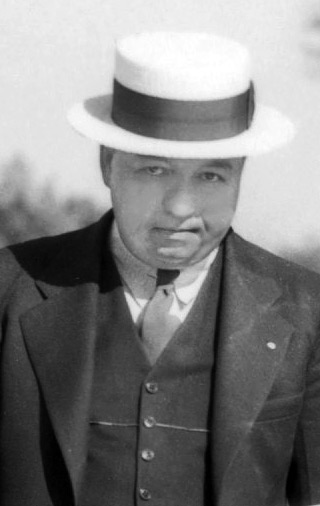 Albert Leo Boyd was born in Washington D.C. to local physician
George Washington Francis Boyd and his wife Clara R. Esch Boyd on Aug.
20, 1898. Albert was the
youngest
of seven children according to their 1900 Census in DC.
The record showed every member of the Boyd family was born in the Dist.
of Columbia. George's father was born in Ireland and his mother in
Maryland. Clara's parents were born in Germany. (These
columns have been omitted.) George and Clara had been married for
16 years and all seven of their children were living in the home. The Boyds were well off, they had a live-in nurse as well as a cook (from
Ireland.) Albert Leo Boyd was born in Washington D.C. to local physician
George Washington Francis Boyd and his wife Clara R. Esch Boyd on Aug.
20, 1898. Albert was the
youngest
of seven children according to their 1900 Census in DC.
The record showed every member of the Boyd family was born in the Dist.
of Columbia. George's father was born in Ireland and his mother in
Maryland. Clara's parents were born in Germany. (These
columns have been omitted.) George and Clara had been married for
16 years and all seven of their children were living in the home. The Boyds were well off, they had a live-in nurse as well as a cook (from
Ireland.)
1900 Census, Washington DC, E.D. 120,
121 2nd St. NE
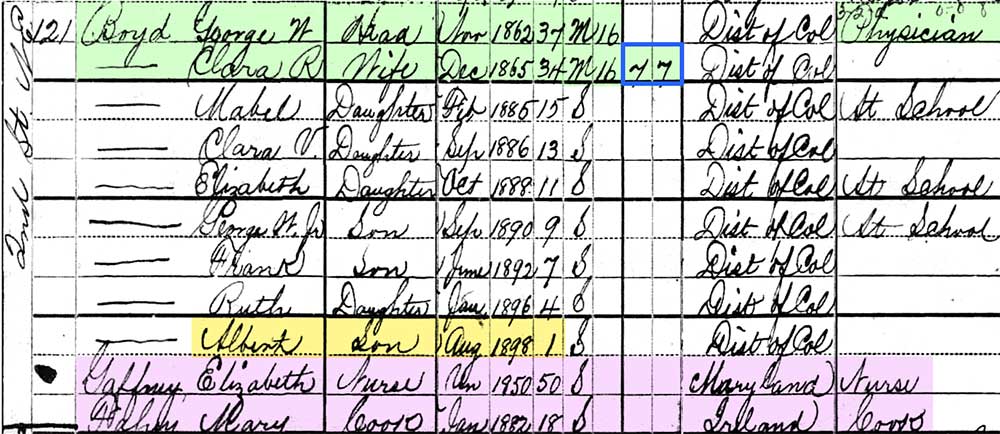
At age 12 Albert
served as a Congressional page boy during the administration of Woodrow
Wilson. (According to Boyd's obituary.) Notice on his 1910
Census below, Albert was 11 years old, but would turn 12 that August.
Living in the next dwelling was Samuel Stough, a 49 year old secretary
to a congressman. It's highly probable that it is through Stough
that Albert was able to work as a congressional page boy, and probably
for the congressman that Mr. Stough assisted. Notice also that
Clara has only 6 living children and Mabel is missing.
1910 Census, Washington DC,
121 2nd Street NE

According to the Virginia
Bureau of Vital Statistics, County Marriage Registers,
Albert married Dorothy Chappelear
in Alexandria, Virginia on Dec. 12, 1916. Albert
claimed he was 23, but he was actually only 18. Dorothy claimed
she was 18, but she was actually born in 1901 and would have been around 15 years old at
the time. She was one of two daughters of Andrew Leroy Chappelear
and Marian "Mamie" Sheppard Anderson Chappelear.
1910 Census, Pct. 2,
Washington DC, 1418 12th St. NW (Leroy's first initial is incorrect.)

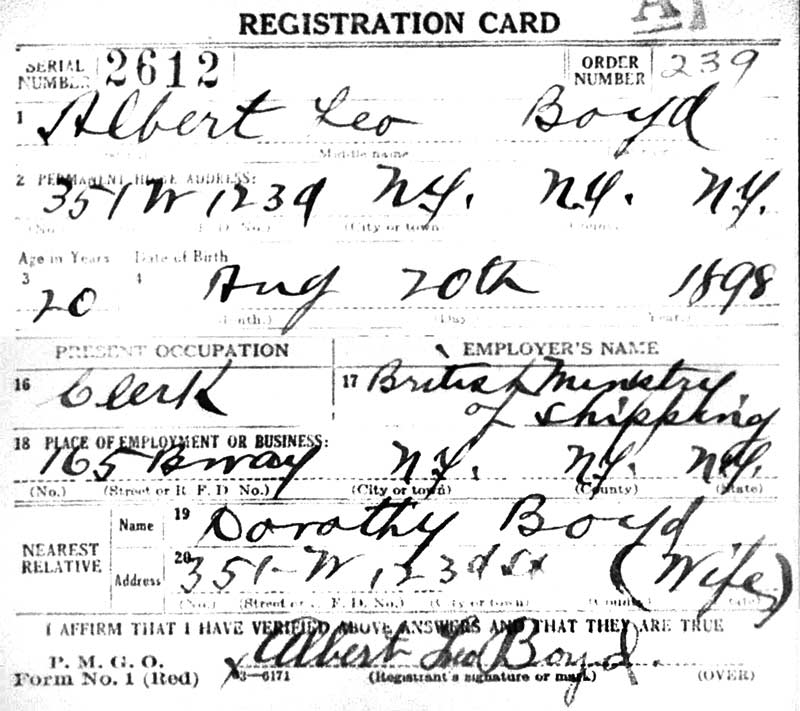
In 1918 Albert registered
for the WW1 draft in NYC. His registration card shows he was 20 years old and
worked as a clerk for the British Ministry of Shipping at 165 Broadway.
He lived at 351 W. 123rd St. with his wife, Dorothy Boyd.
Albert & Dorothy's 1920 Census
seen below shows
them living in Washington DC with Dorothy's divorced mother, Mary Chappelear.
Albert was 21 and working as a salesman in a drugstore. Dorothy
was 18, born in Maryland, and she and Albert had a 2 mo. old daughter,
Dorothy V. Boyd.
1920 CENSUS, Washington DC,
125 4th Street, SE

It's possible the "V." should have been for Albert's wife instead of
their daughter.
The Boyds (or possibly only
Albert) came to Tampa in 1922 where he and Dorothy divorced in Jan.
1924. Dorothy then went to New York City and married Nicholas De Rasmo there on May 23, 1929. It is assumed her daughter went with her.
Their 1930 census hasn't been located, but the marriage didn't last very
long. They got a quickie divorce in Reno, Nevada on Jan. 2, 1932.
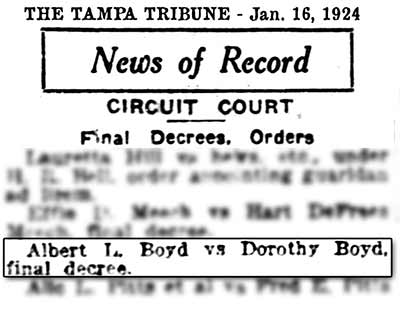 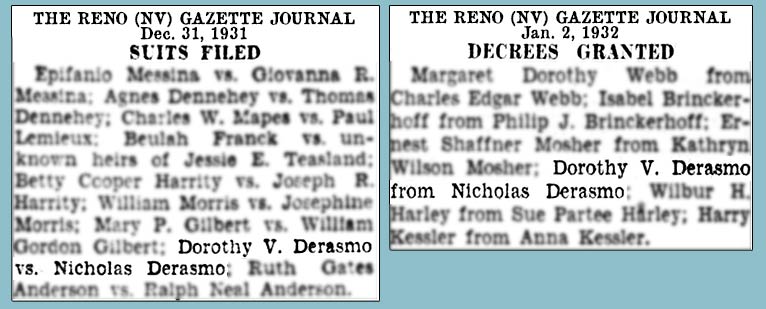
On Apr. 17, 1924, Albert Boyd married Miss Mary E. Middlebrook at Wauchula, Hardee County, Fla. He was 26, she
was 18. Mary was born Jun. 25, 1905 and was a daughter of Levi Cohen Middlebrook, a
carpenter, and his wife Nancy Jane Watson, both natives of Georgia. Their
consent for Mary's marriage is filled out on their marriage license.
See their marriage license.
See Mary's parents' affidavit.
ALBERT
BOYD IN THE REAL ESTATE BUSINESS
In 1925 and 1926 Albert
Boyd was in the real estate business. Even
though this was just after the peak of the Florida land boom, there was
still a decent fortune to be made in real estate. Maybe not in
huge land acquisitions, but in Tampa there was still a considerable
influx of northerners. These were the years that D. P. Davis
developed Davis Islands. Many bridges and civic improvements in
Tampa were made in the mid 1920s. Boyd frequently placed
classified ads for sales of specific homes in and around Tampa, as well
as undeveloped land in the area and as far as Plant City and south
Florida. He kept a running ad going to induce sellers to bring
their listings to him.
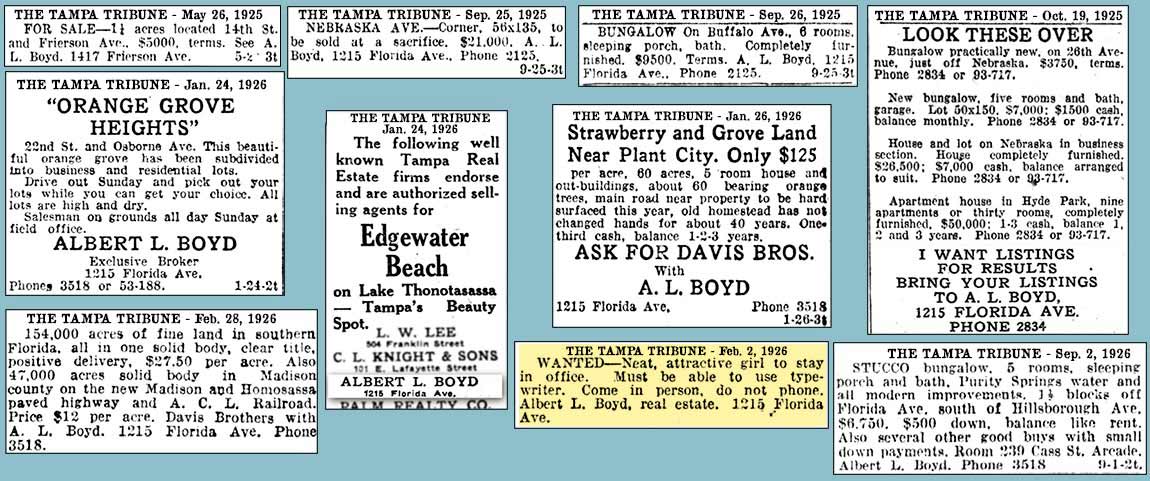
It appears that
Albert was in business on his own at first, working from
his home at 1417 Frierson, but by late Sep. 1925 he had an office at
1215 Florida Ave. In late Jan. 1926, he was teamed up with the Davis
Bros. and in early Feb. 1926 he advertised for "a neat, attractive girl
to stay in office. Must be able to use typewriter." The ad
insisted she come in person and "do not phone."
CAREER
CHANGE FOR ALBERT BOYD - AUTO FILLING STATION & BAIL BONDSMAN
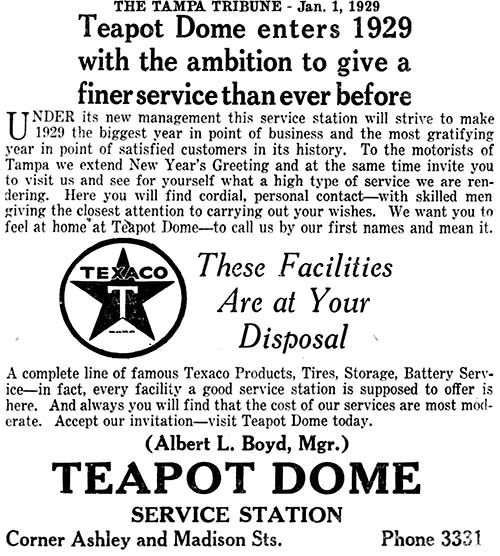 In late 1928 Albert became
the manager of the "Teapot Dome" Texaco service station at the corner of
Ashley and Madison Streets. Advertising on Jan. 1, 1929 "Under its
new management, this service station will strive to make 1929 the
biggest year..." by rendering a "high type of service." He offered
"cordial, personal contact--with skilled men giving the closest
attention to carrying out your wishes." In late 1928 Albert became
the manager of the "Teapot Dome" Texaco service station at the corner of
Ashley and Madison Streets. Advertising on Jan. 1, 1929 "Under its
new management, this service station will strive to make 1929 the
biggest year..." by rendering a "high type of service." He offered
"cordial, personal contact--with skilled men giving the closest
attention to carrying out your wishes."
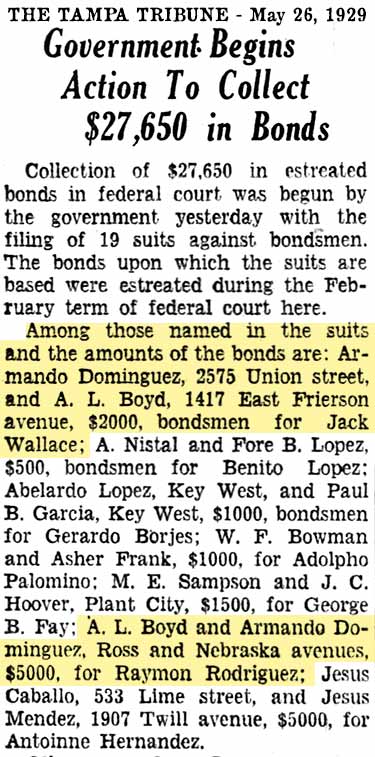 It also appears that in the
late 1920s, Albert Boyd was in the bail bonds business. He was in
the papers for various cases, some very high profile capital crimes
cases, with at least one other bondsman listed-- Armando Dominguez.
In May 1929, an article appeared in the Tribune "Government Begins
Action To Collect $27,650 in Bonds." Among the dozens of bondsmen
listed were Armando Dominguez of 2575 Union St. and A. L. Boyd of 1417
E. Frierson Ave., bondsmen for Jack Wallace, for $2,000, and A. L. Boyd
& Armando Dominguez of Ross and Nebraska Avenues, bondsmen for Raymond
Rodriguez, for $5,000. It also appears that in the
late 1920s, Albert Boyd was in the bail bonds business. He was in
the papers for various cases, some very high profile capital crimes
cases, with at least one other bondsman listed-- Armando Dominguez.
In May 1929, an article appeared in the Tribune "Government Begins
Action To Collect $27,650 in Bonds." Among the dozens of bondsmen
listed were Armando Dominguez of 2575 Union St. and A. L. Boyd of 1417
E. Frierson Ave., bondsmen for Jack Wallace, for $2,000, and A. L. Boyd
& Armando Dominguez of Ross and Nebraska Avenues, bondsmen for Raymond
Rodriguez, for $5,000.
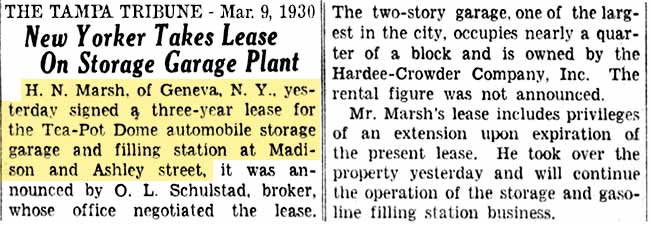
Some time by March of 1930,
Boyd gave up his lease at Teapot Dome Texaco.
THE GREAT
DEPRESSION YEARS
Albert & Mary Boyd's 1930
Census in Tampa showed them living in a home they owned at 1417 Frierson
Ave.. Albert was 31 and born in District of Columbia, Mary was 23
and born in Florida. This census asked at what age did each person
marry. Both show they were 17, which indicates Albert first
married around 1915 to 1916 (his marriage to Dorothy Chappellear.)
Albert was proprietor of a filling station,
but it may not have been Teapot Dome. The census date was April 1,
so it's possible he's already acquired another filling station.
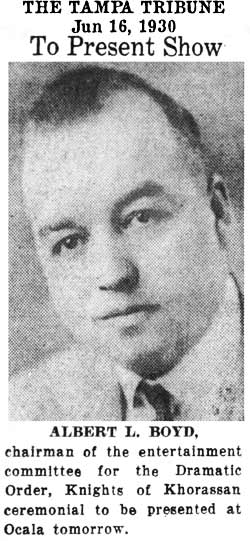 KNIGHTS
OF PYTHIAS FRATERNAL ORDER KNIGHTS
OF PYTHIAS FRATERNAL ORDER
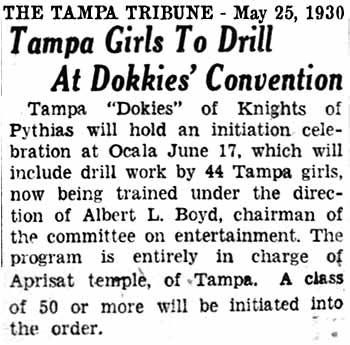 By 1930 Albert was a member of the Knights of Pythias and D.O.K.K --
Dramatic Order, Knights of Khorassan lodges.** Boyd was on the
entertainment committee. It is this activity that seems to have
inspired Boyd to be a "showman," albeit of strange and wild
animals, but still, this was entertainment. By 1930 Albert was a member of the Knights of Pythias and D.O.K.K --
Dramatic Order, Knights of Khorassan lodges.** Boyd was on the
entertainment committee. It is this activity that seems to have
inspired Boyd to be a "showman," albeit of strange and wild
animals, but still, this was entertainment.
In late May of 1930, Albert
was in charge of the entertainment at a "Dokies" initiation celebration
in Ocala to be held June 17. As chairman of the entertainment
committee of Tampa's Apmat temple, Boyd was in charge of training a
"drill team" of 44 Tampa women who were to perform at the initiation of
about 50 new lodge members. Boyd also arranged for the dancing
team of Augusti and Rente, a couple that had been appearing at the
Alcazar Roof Supper club in Miami.
** According to Wikipedia, The Dramatic Order of the Knights of
Khorassan or Dokeys/Dokkies are a side degree of the Knights of Pythias,
somewhat analogous to the Shriners in Freemasonry. The Order was founded
in 1894.
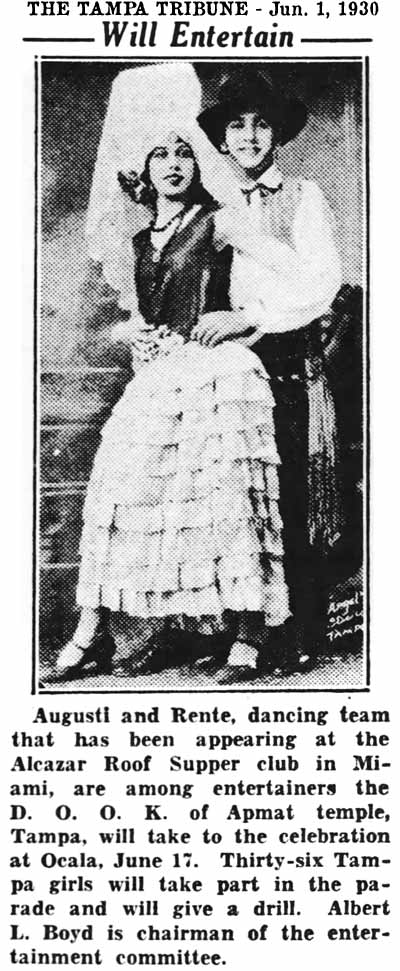 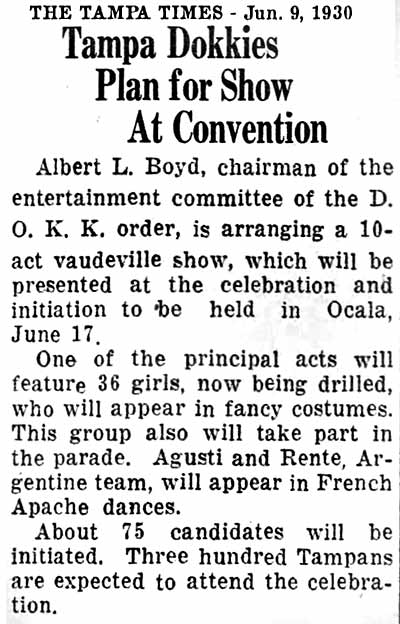
In all, the show would
consist of 10 vaudeville acts. The Times article of Jun. 9, 1930 said 36
girls would perform in fancy costumes in a parade, the Argentine team of
Agusti and Renti would appear in French Apache dances, and about 75
candidates were to be initiated into the DOKK. Three hundred
people from Tampa were expected to attend the event.
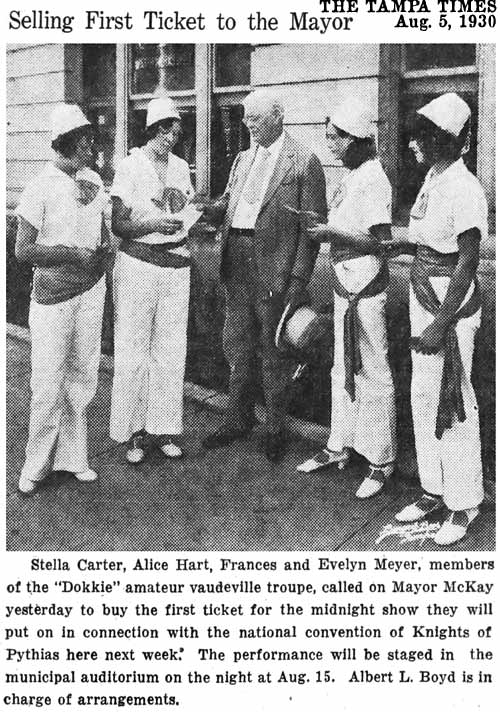
On Aug 15, 1930, Boyd's "Dokkie"
vaudeville troop performed at the municipal auditorium for the Knights
of Pythias annual convention. Mayor McKay bought the first ticket
for the event.
| |
|
KNIGHTS OF PYTHIAS ANNUAL CONVENTION, TAMPA
The
article which accompanied these photos consisted
only of a state by state list of attendees.
Two
acts here of particular interest are the man
holding a snake (Pinkie Williams, a singer,) and
the circus wagon which appears to contain wild
animals.
Perhaps this is what gave Boyd
the incentive to begin his collection of wild animals.
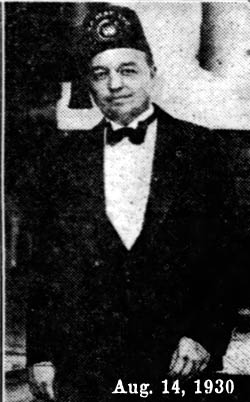 |
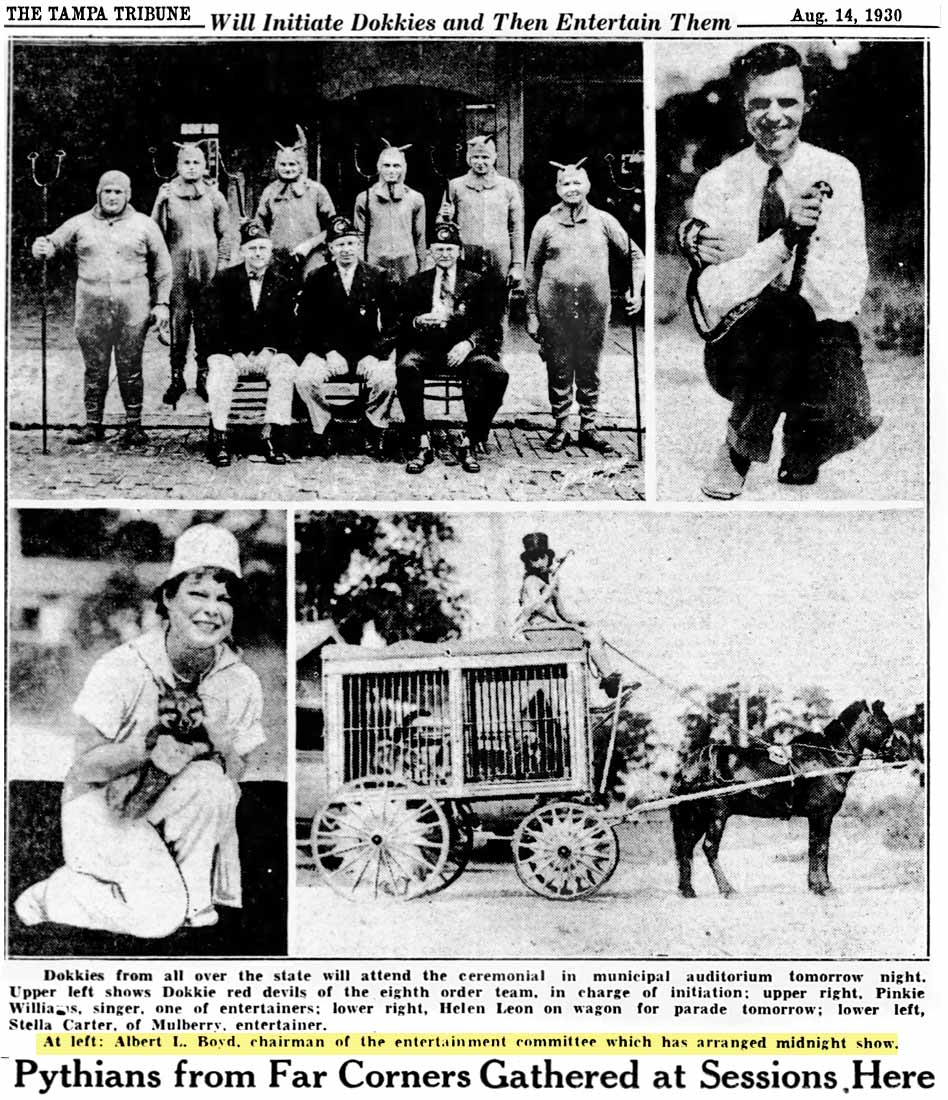 |
BANKRUPTCY THEN HIT BY A TRUCK
By Oct. 1931, the Boyds
felt the impact of the Great Depression and filed for Federal voluntary
bankruptcy protection. Albert's liabilities totaled $42,200 and his
assets were $30,000.
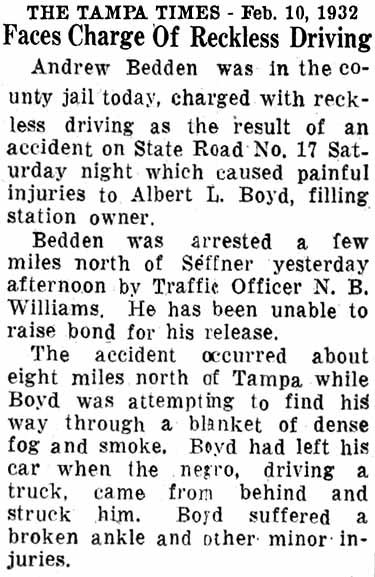 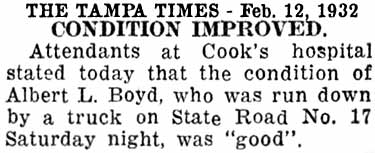 On Feb.
6, 1932, Albert Boyd
also felt the impact of a truck. He was painfully injured when he was hit by a truck while walking along the
side of State Road No.17 several miles east of Tampa. Boyd had
pulled off the road and was trying to find his way through the dense
morning fog and smoke when he was struck by a Furtel Farms Company truck On Feb.
6, 1932, Albert Boyd
also felt the impact of a truck. He was painfully injured when he was hit by a truck while walking along the
side of State Road No.17 several miles east of Tampa. Boyd had
pulled off the road and was trying to find his way through the dense
morning fog and smoke when he was struck by a Furtel Farms Company truck
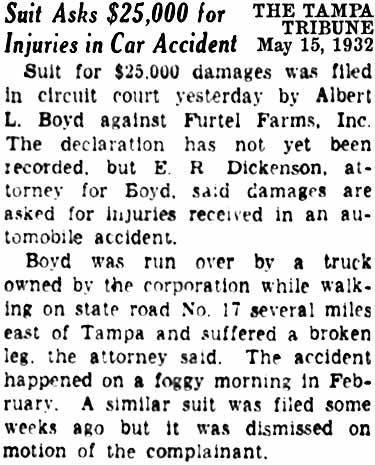 driven by a Seffner man. Boyd suffered a broken leg and in mid-May, 1932, he filed suit against the Furtel Farms company for
damages of $25,000.* The article stated that a similar case such
as this one had been brought to court recently and was dismissed. driven by a Seffner man. Boyd suffered a broken leg and in mid-May, 1932, he filed suit against the Furtel Farms company for
damages of $25,000.* The article stated that a similar case such
as this one had been brought to court recently and was dismissed.
Nothing further seems to
have been published about the outcome of this case (which was not
unusual for the Tampa Times.)
It's not known what the outcome was for Albert's bankruptcy, the bail
bonds issue, or the outcome of his lawsuit for his injury.
In 1932 Boyd began a hobby of
collecting strange and exotic wild animals in his back yard.
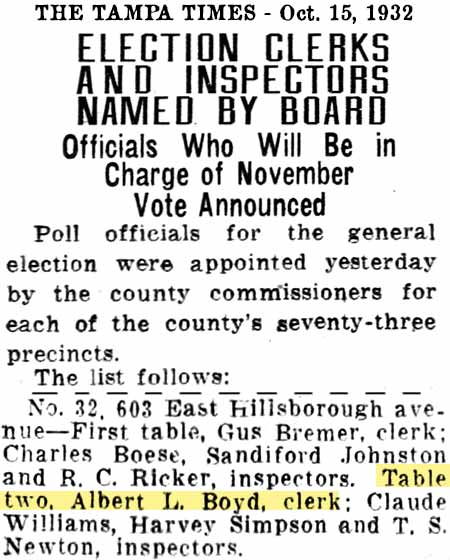
In Oct. of the same year, Albert
Boyd was chosen to be one of two elections clerks for the November
election, along with six elections inspectors at Precinct 32, 603 E.
Hillsborough Ave.
MRS. BOYD FILES LAWSUIT
Then in Sep. 1932, we learn
that Mrs. Boyd was walking with Albert at the time of the accident, and
she sued Furtel Farms for "permanent injuries" she received when
she dodged the truck and fell. This comes as a surprise as no
mention of her was made in the original accident articles or the first
lawsuit articles. Suing for nearly $3,000,* the jury awarded her
$700* on Oct. 26, 1932. No mention was made of Mr. Boyd's earlier
lawsuit.
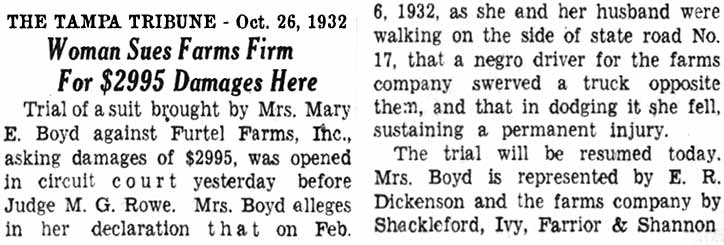
*$25,000 in 1932 would be
like $487,325 to us today. Mrs. Boyd's damages sought would be
like $58,478.98 to us today, and her $700 award would be like $13,645 to
us today.
U.S. Bureau of Labor Statistics CPI Inflation Calculator
ALBERT BOYD'S
FIRST FILLING STATION AT NEBRASKA & HILLSBOROUGH AVES., BEFORE SUNOCO
Within a month after his wife was awarded $700 for her lawsuit against Furtel Farms,
preparations to vacate the northeast corner of Nebraska & Hillsborough
avenues for a new filling station were being made by Charles Elsinger,
presumably the property owner.
In late Nov. 1932, Elsinger applied for a permit to move a house from near the corner at
5401 Nebraska Ave eastward to the back half of
the lot. It's not yet known if Boyd was involved with this
property at this time.
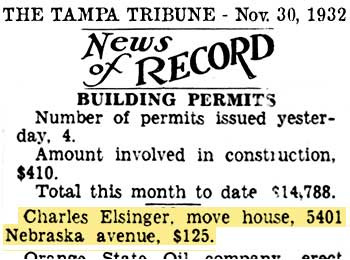 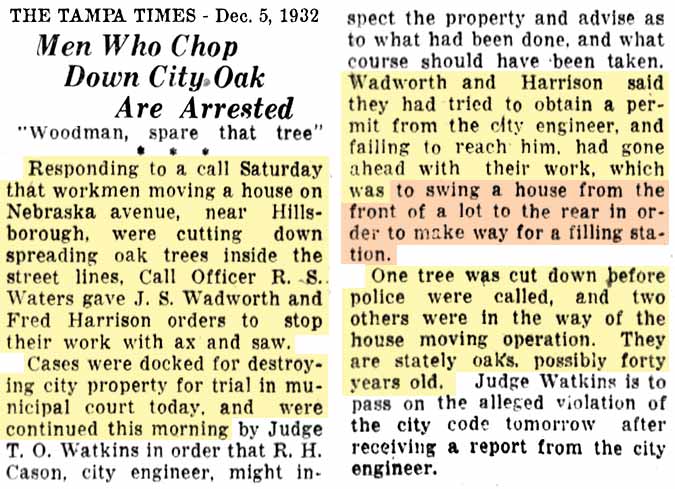
Then trouble started two
days later when the movers started chopping down trees without a permit, that were in the
way, Apparently, the trees were on city property, and someone
called the police when they saw what was happening.
One tree had already been
cut down before the police were called, and two more "stately oaks
possibly forty years old" were still in the way. The title of
the article at right says the two men were arrested, but the story
claims that Officer Waters gave them orders to stop their work. So
"arrested" seems to mean they were stopped. The men were on trial
in municipal court on Dec. 5, but the case was
continued until "tomorrow after receiving a report from the city
engineer."
And in the usual style of
the Tampa Times, no follow up story was ever printed. Not in 1932
or 1933.
The 1931 Sanborn map below,
courtesy of the University of Fla. Library digital map collection, shows
a small wood frame filling station already existed at the southeast corner in 1931.
Upcoming articles indicate this was Boyd's "Nebraska Sales" station.
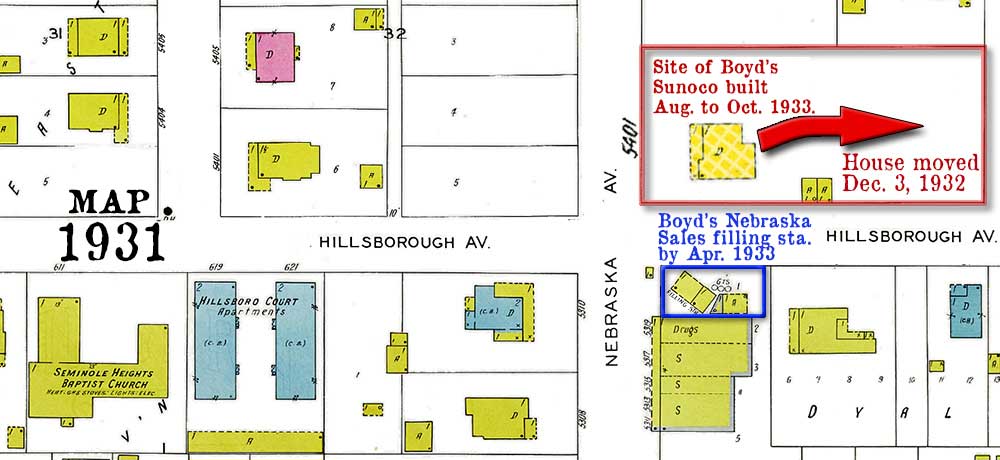
BOYD'S NEBRASKA SALES FILLING STATION
Before the Aug. 1933
construction of the Sunoco at the NE corner of Nebraska & Hillsborough
Ave. had started, Boyd already owned the small station on the
south side of Hillsborough Ave at the SE corner by April 1933.
There are many possible
circumstances for this arrangement. One might be that Boyd left
the Teapot Dome Texaco sometime around early 1930 and bought the small station
before April 1933. (See next article below.)
Being a highly-traveled
intersection by incoming tourists, business could have been
pretty good (considering this was the early years of the Great
Depression.) Then wanting to expand but having no room to do so
with the stores on the south side of the station, maybe he made an offer
to Charles Elsinger; something to the effect of "If you move your
house over, I'll make you a great offer on the Nebraska end of your
property." This is all speculation.
|
This Apr. 3, 1933 article
lists filling stations which have been designated as tourist information
centers. Number six is "Hillsborough and Nebraska Avenues,
'Nebraska Sales,' A. L. Boyd." |
Place your cursor on the map to see the area
outlined in red enlarged--proof that Boyd first
operated out of the small station at the SE
corner.
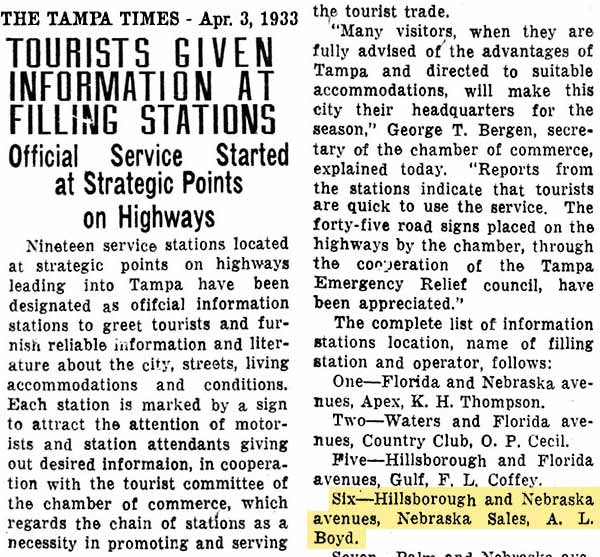 |
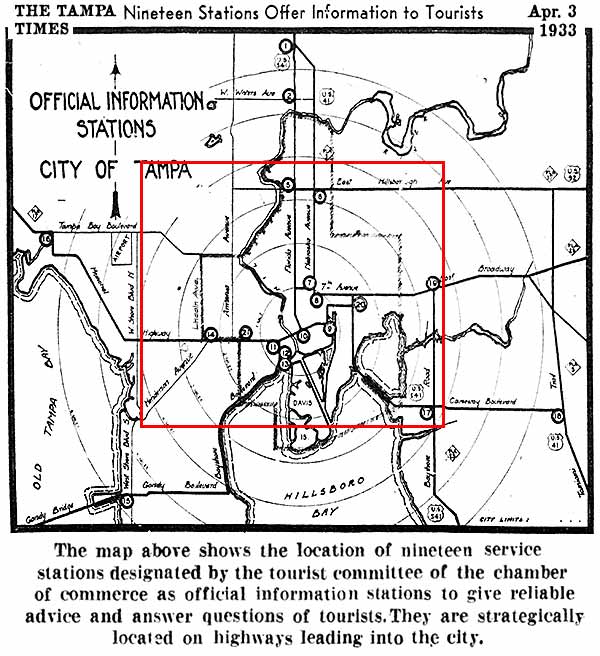 |
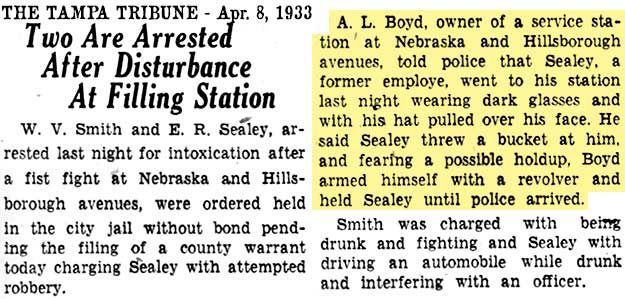
ALTERCATION AT BOYD'S NEBRASKA SALES STATION
Just five days after the
above article listing "Nebraska Sales" as a tourist info center at
Nebraska and Hillsborough Avenues, this Apr. 8 article describes an
altercation at the service station at Nebraska and Hillsborough owned by
A. L. Boyd. A former employee of Boyd's , E. R. Sealey, showed up last night
wearing dark glasses and a hat pulled over his face, and threw a bucket
at Boyd. Fearing a possible holdup, Boyd armed himself with his
revolver and held Sealy until police arrived.
ELSINGER OBTAINS A PERMIT TO BUILD A FILING STATION
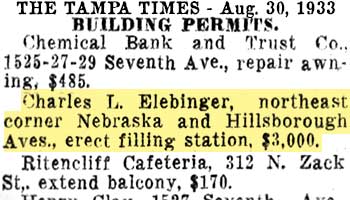
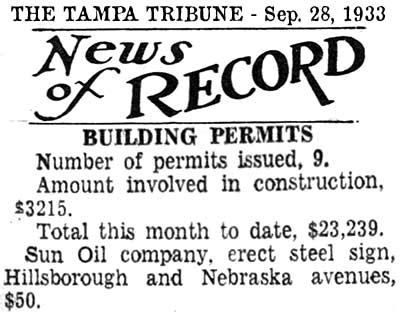
The same person (name
misspelled) who took out the permit to move the house at the northeast
corner of Nebraska and Hillsborough avenues took out another permit in
late Aug. 1933 to build a filling station there. His name was
Charles "Elsinger" not "Elebinger."
The "finishing touch" or "tree topper" you
might say, was the installation of a steel Sun Oil Co. sign in late Sep. 1933. This leaves a little over two weeks for Boyd to
get the place ready for business.
BOYD'S
NEW SUNOCO FILLING STATION OPENS
In 1933,
Albert Boyd opened his spiffy, brand new Sunoco service station at the
northeast corner of Hillsborough Ave. and Nebraska Ave. Assuming his
3-year anniversary celebration date is correct in a 1936 article, it opened Oct. 17, 1933.
Nothing was found in the papers concerning the station opening or being in business until Nov. 21,
1933 when an article names two men charged with breaking and entering
the station on Oct. 27. In these days, filling stations were very
frequent targets of hold-ups, armed and unarmed, and burglaries.
Many involved shots being fired and employees or owners killed.
By this time, Boyd's
backyard zoo had grown into a small circus and he relocated it to his service
station where he had cleared space around the building.
|
The Sep. 18, 1934
article below says Boyd's hobby of collecting
animals and plants "began two years ago..." which would
have been around Sep. 1932, but the photo of Boyd with a
Gila monster in May 1931, mentions his already
"fast-growing zoo." |
|
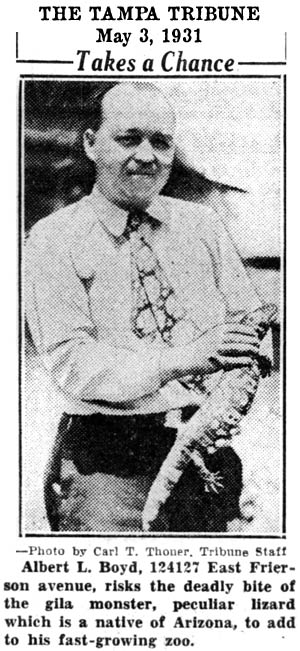
His correct address was 1417. |
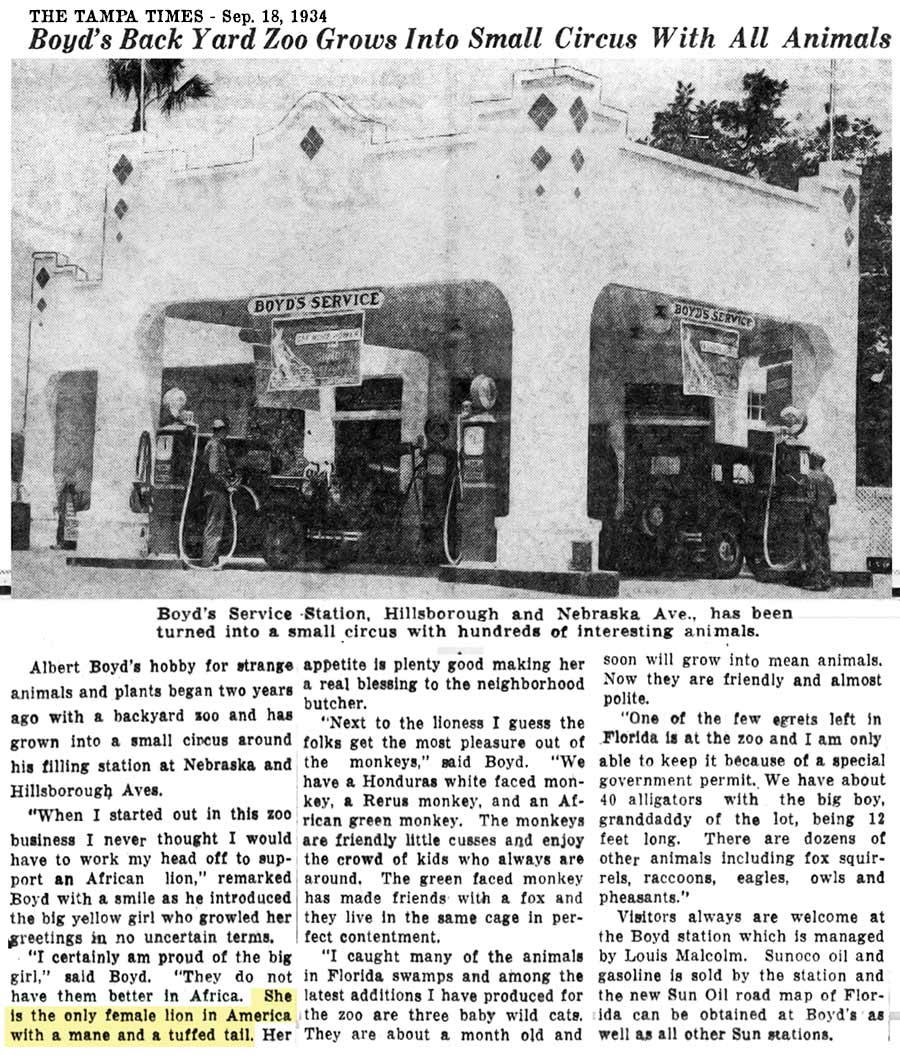 |
According to these articles, in addition to a
Gila monster, Boyd had a female African lion
(named "Beauty") with a mane and tufted tail (the only one in
America he said), a Honduras white-faced monkey,
a Rhesus monkey, and an African green monkey, a
fox, three baby wildcats, an egret, 40
alligators (one 12 feet long), squirrels,
raccoons, eagles, owls and a falcon, as well as
dozens of other animals.
Boyd said he caught many of the animals in
Florida swamps. |
|
Boyd promoted
Beauty, a lioness, as a "bearded lady" because
she had male characteristics such as a mane and
tufted tail. This is rare, but several
documented instances of female lions exhibiting
male characteristics can be found on the
Internet.
The photos below are from the article above.
|
|
'NOLES VS. GATORS - THE REAL DEAL
Seminole Chief
Osceola's son was going to wrestle a 12-ft. long
alligator at Boyd's, and the chief was going to
be there. This gator was probably "Bozo"
seen in photos below.
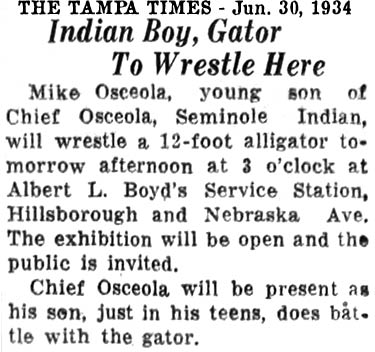 |
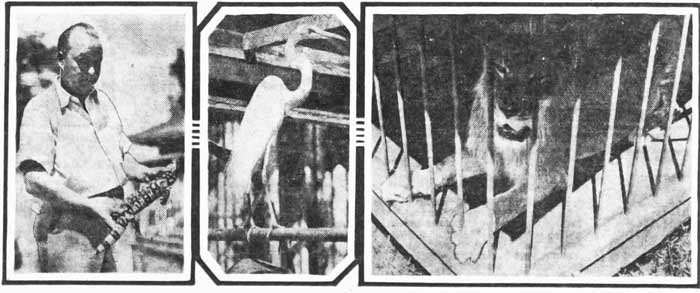 |
|
 |
It took
all of five minutes for Mike Osceola to pin the gator.
But it wasn't Bozo, this one was "only" an 8-ft long
gator. The reference to the "grunt-and-groaners"
at Benjamin field was for the wrestling matches held
there every Friday night. Benjamin field today is
the area of the former Ft. Homer Hesterly Armory, now
the Jewish Community Center.
The event
at Boyd's was purely a publicity stunt, as "Several
hundred persons stood in the blazing sun..." The event
was free and not even donations were taken. The
Tribune writer (and probably the crowd) seems like he
wanted some serious bloodshed.
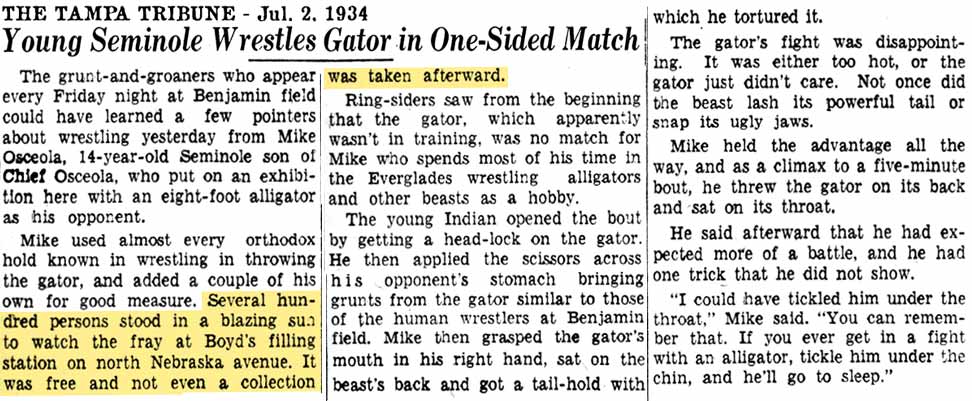
THOUSANDS VISIT BOYD'S ZOO
|
|
Boyd started
collecting animals at his home several years
ago, but so many people came to his home to see
the animals that when he built his new filling
station he made room for the big zoo and a
tropical garden in the back. At this time
it was said he had more than 400 gators,
including a "granddaddy of them all, believed to
be several hundreds years old" and has a whole
pool to himself. The other gators are
grouped by size to each pool, so no one gator
could dominate the pool.
Boyd had a wildcat
that was two years old and raised with his pet
dog and his cat. He claimed that the animal
was
as tame as either of his pets. The wildcat
was taken from its mother before his eyes were
open. An article presented later in this
feature shows the wildcat did not belong to
Boyd, but would be loaned to exhibit at his zoo
from time to time by its owner who lived in the
Hyde Park section of Tampa. The cat was
also known by two different names.
Beauty, the lion, "is friendly and
the attendant goes in the cage to feed her."
But Beauty is agitated by photographers ever
since one took a flash picture of her and
startled
her.
Boyd invited
school teachers to bring their classes to the
zoo and explained the habits of all the animals.
|
|
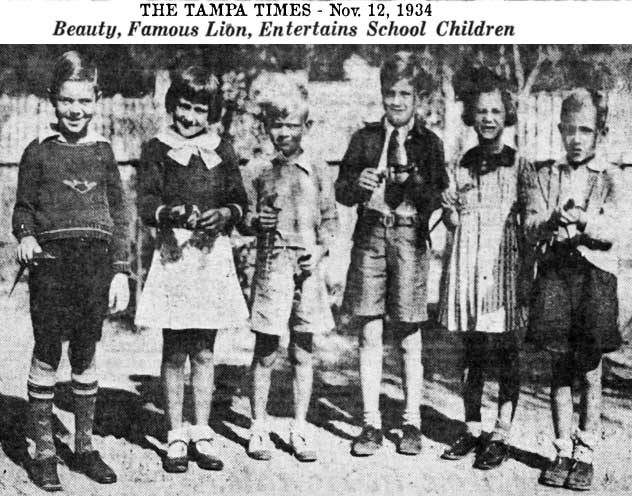 |
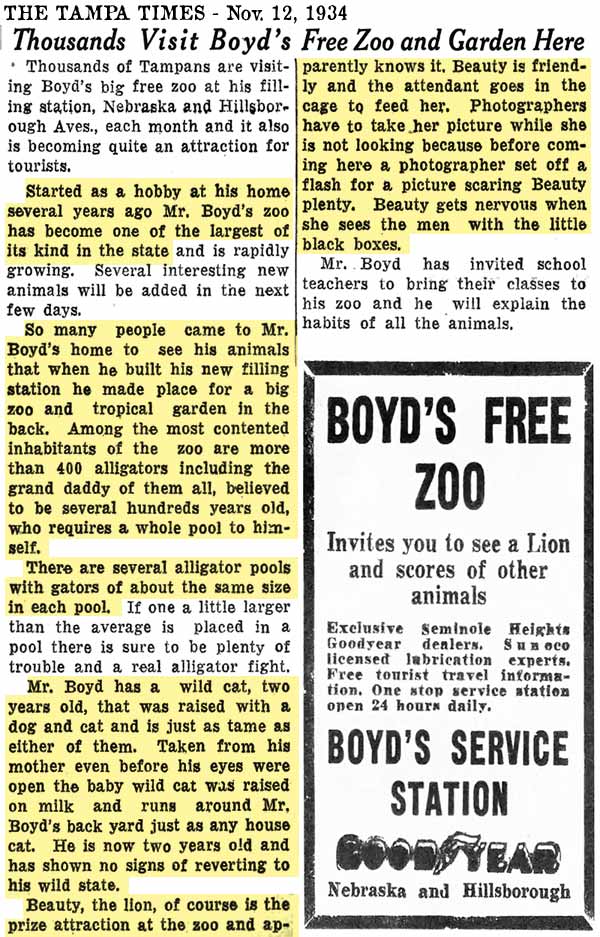 |
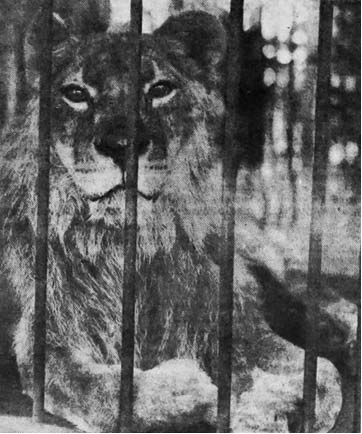
"Children from the Seminole School enjoyed a big
free show last week at Boyd's Service station,
Hillsborough & Nebraska Aves., where Beauty, Mr.
Boyd's famous lion, and scores of other
interesting animals put on a show that would
thrill any children. Beauty apparently
enjoyed every moment of the party as you can see
from the interested expression on her face in
this picture." |
| |
|
|
JIMMY THE BABOON AT BOYD'S ZOO
"Jimmy enjoys
crowds at his new home, but where was his
old home? He has a weakness for peanuts and
crowds. Loves crowds, doesn't like being
alone. Nothing is said here
about Jimmy's past. Maybe the articles
at right have something to do with it.
|
TWO WEEKS BEFORE THE PHOTO
Despite his weakness for peanuts and crowds,
Jimmy showed a bit of strength when he
didn't like being prodded from cage to cage.
Leonard Porter was seriously injured by
Jimmy when he slashed at Leonard's arm,
severing a main artery. Porter was
unconscious for several hours after the
attack, but improved enough by the next day
to possibly be discharged from the hospital. |
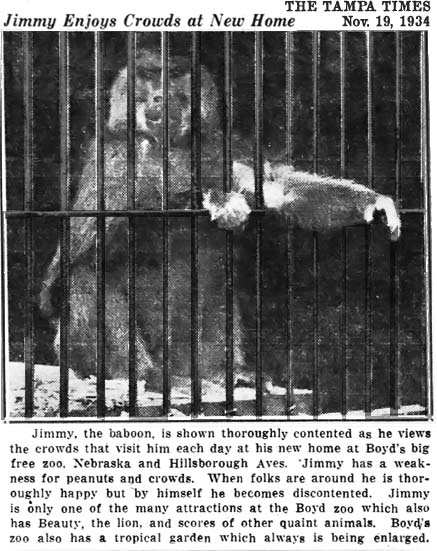 |
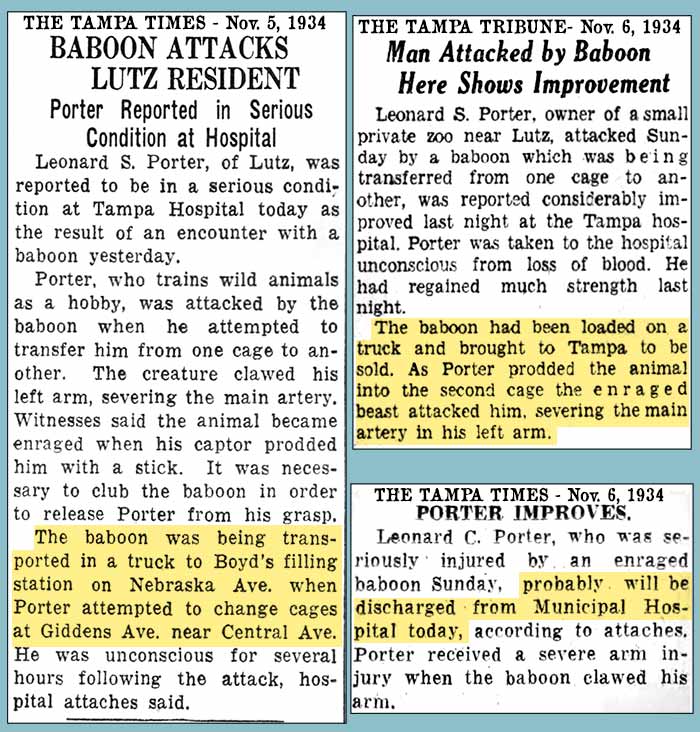 |
Thousands of visitors are attracted here.
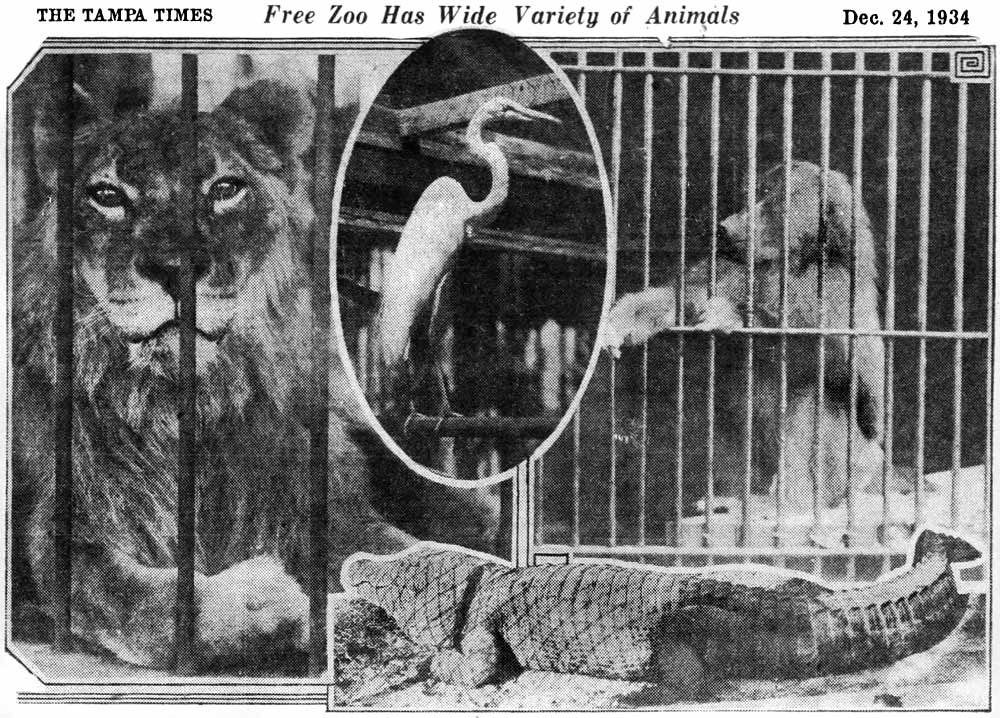

|
BOYD RECEIVES KUDOS FROM LOWELL THOMAS
Lowell
Jackson Thomas (April 6, 1892 – August 29, 1981)
was an American writer, actor, broadcaster, and
traveler, best remembered for publicizing T. E.
Lawrence (Lawrence of Arabia). He was also
involved in promoting the Cinerama widescreen
system. In 1954, he led a group of New
York City-based investors to buy majority
control of Hudson Valley Broadcasting, which, in
1957, became Capital Cities Television
Corporation.
|
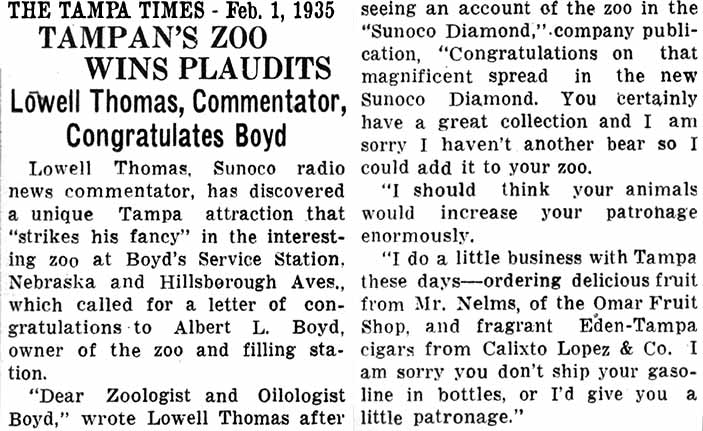 |
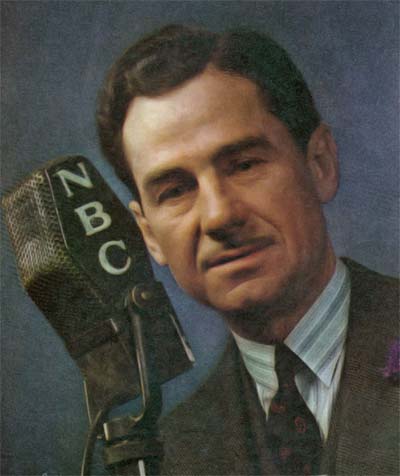
Lowell Thomas, 1939
Courtesy of Wikipedia |
|
Thomas was first heard on radio delivering talks
about his travels in 1929 and 1930: for example,
he spoke on the NBC Radio Network in late July
1930 about his trip to Cuba. Then, in late
September 1930, he took over as the host of the
Sunday evening Literary Digest program,
replacing the previous host, Floyd Gibbons. On
this program, he told stories of his travels.
The show was fifteen-minutes long, and heard on
the NBC Network. Thomas soon changed the focus
of the program from his own travels to
interesting stories about other people, and by
early October 1930, he was also including more
news stories. It was that point that the
program, which was now on six days a week, moved
to the CBS Radio network.
After two
years, he switched back to the NBC Radio network
but returned to CBS in 1947. He was not an
employee of either NBC or CBS, contrary to
today's practices, but was employed by the
broadcast's sponsor Sunoco.
Lowell Thomas info from Wikipedia |
 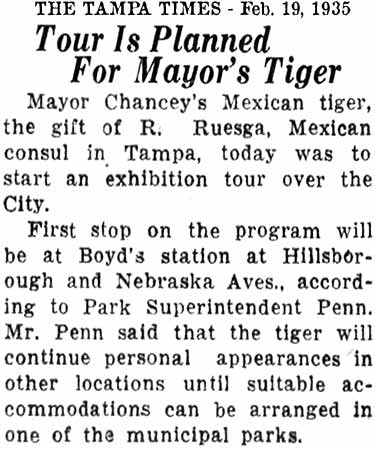
MAYOR'S TIGER GOES
ON TOUR
The young "Mexican tiger" (which was actually an ocelot)
recently given to
Mayor Chancey went on an exhibition tour on Feb. 19, 1935 while a place
was being selected for his permanent residence. The first stop was
Boyd's. By Feb. 21, Plant Park had been chosen for his home,
according to a Tribune
article, Boyd's was to be the cat's temporary home.
Delays in building a
cage for him caused a late move-in date of Apr. 17. Ultimately, it
was named "Bob," probably for the mayor, Robert E. Lee Chancey,
or for "bobcat."
HILLSBOROUGH
COUNTY HUMANE SOCIETY HOSTS FUND RAISER AT BOYD'S
From Sat., Mar 2 through
Mon. Mar. 4, the county Humane Society held a fund raiser at Boyd's.
Ten cents* was charged to enter, and all proceeds were to go to the
organization. Boyd's lioness, "Beauty," was top billing as "the
bearded lady of the lion family." She was taken from Africa to the Bronx
zoo when only a cub, where she was classified as a "he" but it was later
discovered that it was a "she."
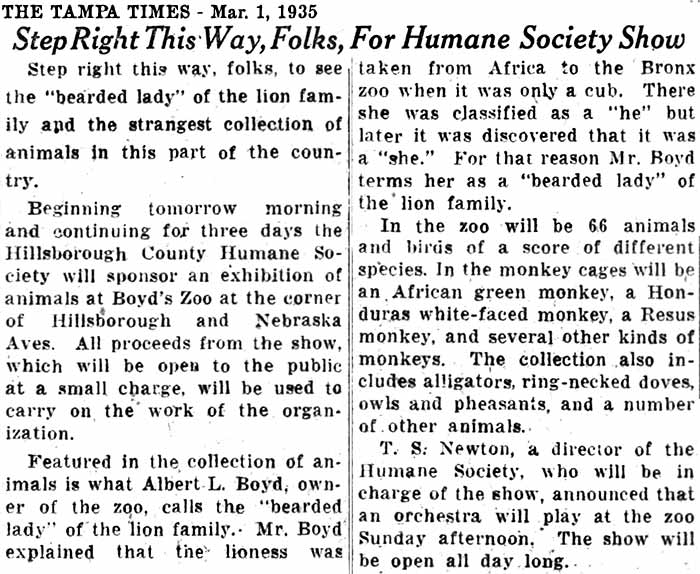
Described as "the
strangest
collection of animals in this part of the country," Boyd's zoo was home
for 66 animals and birds of "a score of different
species." The
monkey collection included an African green monkey, a Honduras
white-faced monkey, a Rhesus monkey, and several other kinds.
Boyd's collection also consisted of alligators, ring -necked doves,
owls, pheasants, and a number of other animals.
*Ten cents in 1935 was like
$1.95 to us today.
T. S. Newton, director of
the Humane Society, would be in charge of the show, and an orchestra
would play live at the zoo on Sunday afternoon.
Below, the Tampa Tribune's article on the
same day featured a photo of Boyd holding a wildcat, attorney Peter O.
Knight, president of the society, Mayor Robert E. Lee Chancey, first VP
of the society, and T.S. Newton, director of the society, holding a
wildcat. This article makes it appear that it was Boyd who
discovered that Beauty was a lioness. It also mentions an egret
and eagles at the zoo.
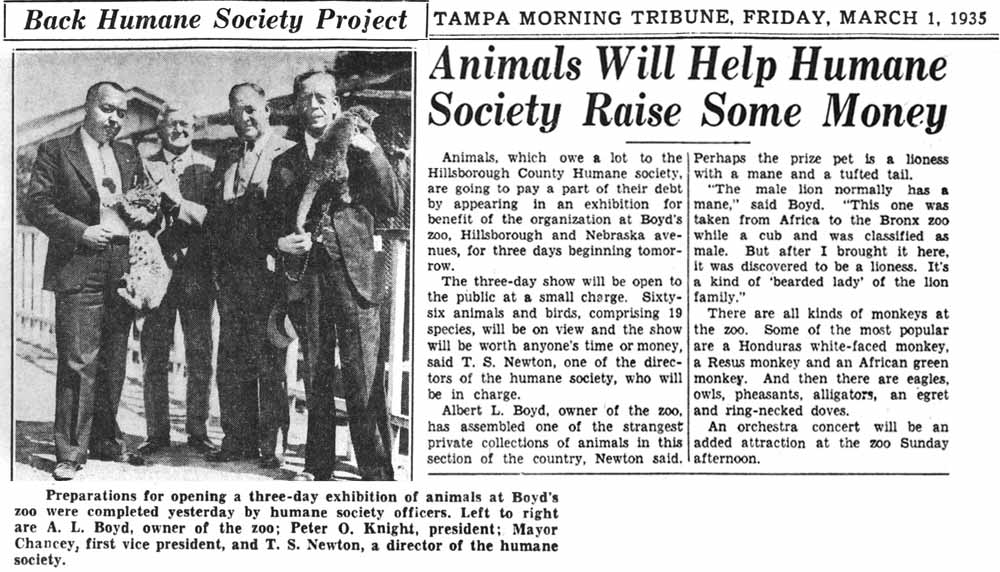
|
THE BOYD'S HAVE A SON
Albert Leo Boyd,
Jr. was born at Cook's Hospital on Apr. 23,
1935. He weighed 8 lbs. 12 oz.
Albert planned to teach him to become a wild
animal trainer when he was old enough. |
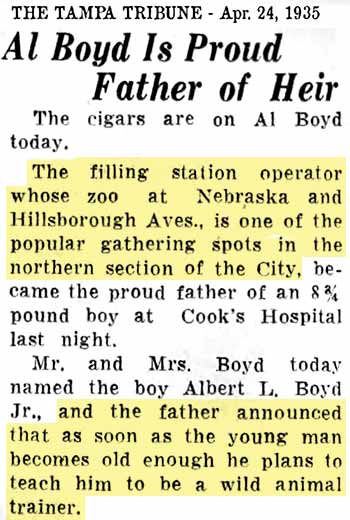 |
|
|
|
|
MISS WILLYS 77 GENERATES
PUBLICITY IN TAMPA
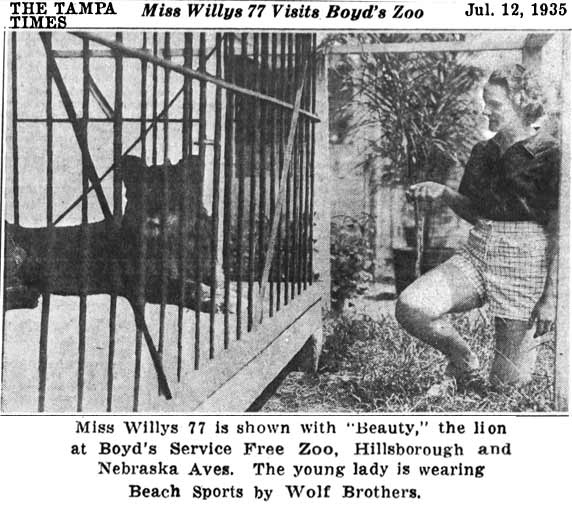 No,
that's not her name and age. No,
that's not her name and age.
"Miss Willys 77" was a
publicity gimmick to promote the new car, the 1935 Willys 77, and boost
sales at local businesses by way of local appearances and a contest with
many prizes.
She and
her sidekick trainer, Bruce Nolan, were "physical culturists."
Their shtick was to go around town showing how physically fit they were by performing
calisthenics on a platform on the back of a truck. Miss Willys,
whose real name was Katherine Miller, arrived in town amid great
mystery, announcing that she was in training to set a new world's
record, but wouldn't yet say at what sport. Thousands "thronged the sidewalks" to see her everywhere
she went.
What better
clothes to wear to a zoo than clothes from WOLF Bros? |
MISS WILLYS' ARRIVAL IN TAMPA
Miss Willys arrived in
Tampa on Jul. 9, 1935, amid great mystery and attention. She was
greeted by Mayor Chancey at the airport along with a welcoming committee
of businessmen. All she would say about her intentions was that
she was going to perform an athletic feat requiring strenuous physical
training, nerve, skill and stamina. To prove that women were equal
to men, she was going to attempt the most "hazardous stunts ever
attempted by any other woman" in attempting to set a new world's record
which was to be announced at a later date. In the meantime, she
and her physical instructor/coach made appearances at numerous
businesses in Tampa. Her training diet
consisted mainly of bread and beer, or so she claimed. (Surprising that
the cigar industry didn't convince her select Hav-A-Tampa
cigars as part of her training diet.)
There was one more column to this article below that was all
the other places they would be performing around town.
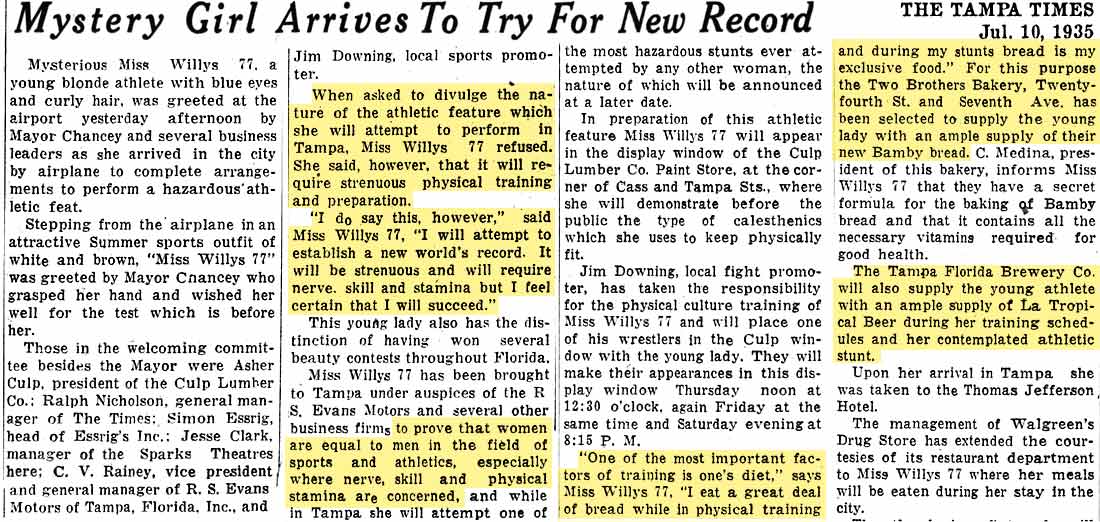
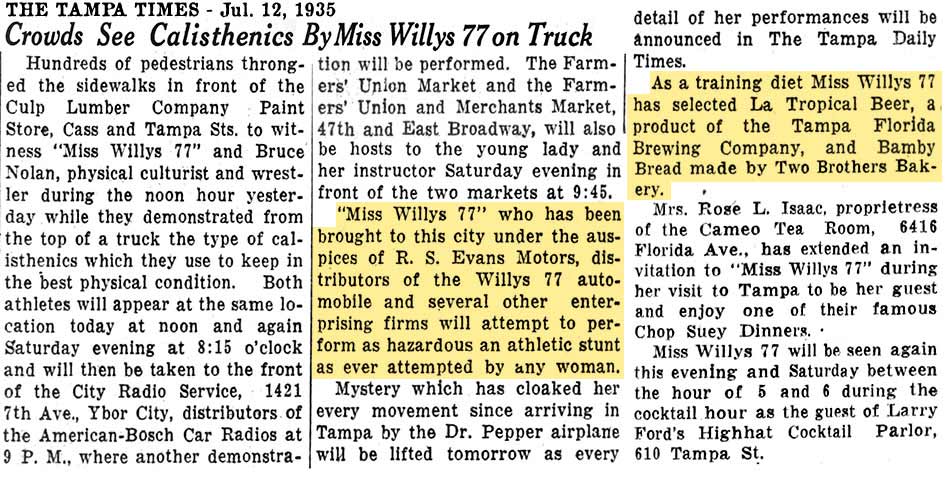
Finally it was announced that her goal was
to set a new world's record for women in non-stop driving. (To
prove "women are equal to men
in the field of sports and athletics, especially where nerve, skill and
physical stamina are concerned.")
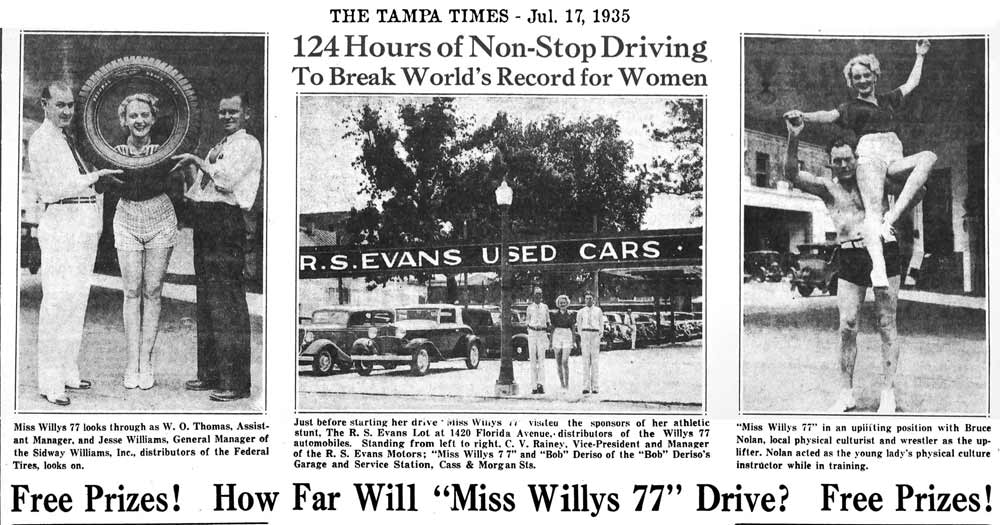
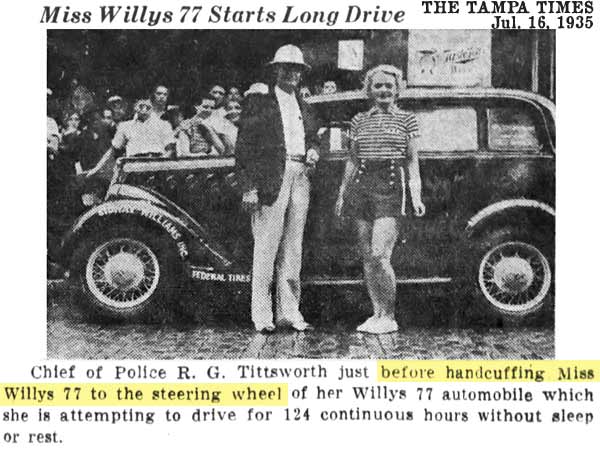
So
much for non-stop driving in handcuffs.
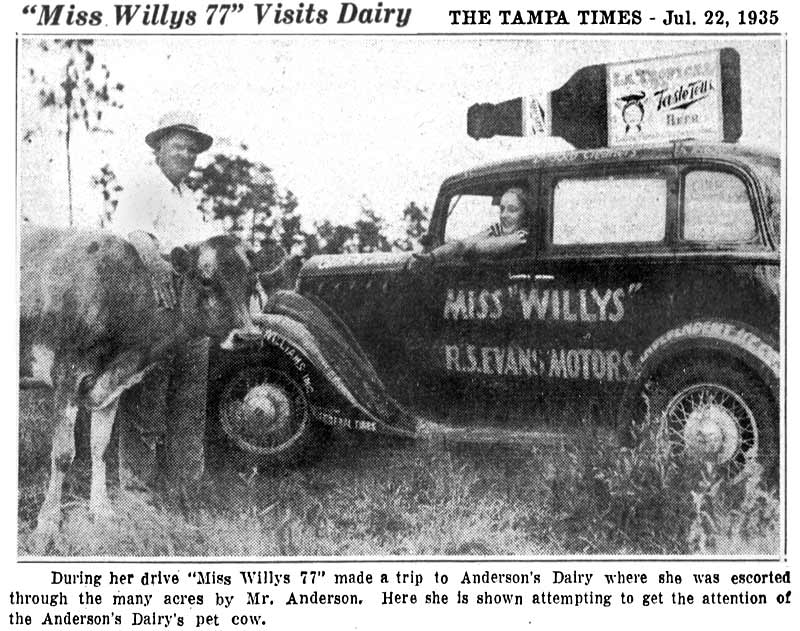
This generated huge publicity, as well as
the prizes for those who came the closest to guessing how
many miles she drove.
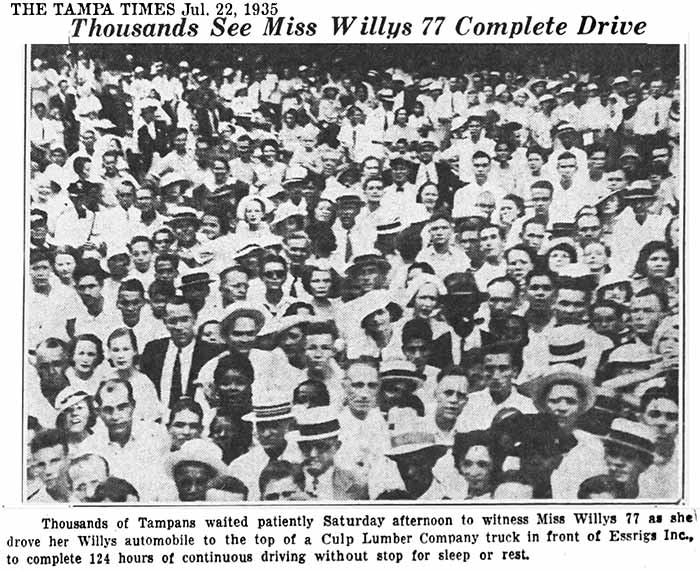
Nothing like driving
71 hours without rest or sleep while drinking beer and eating bread.
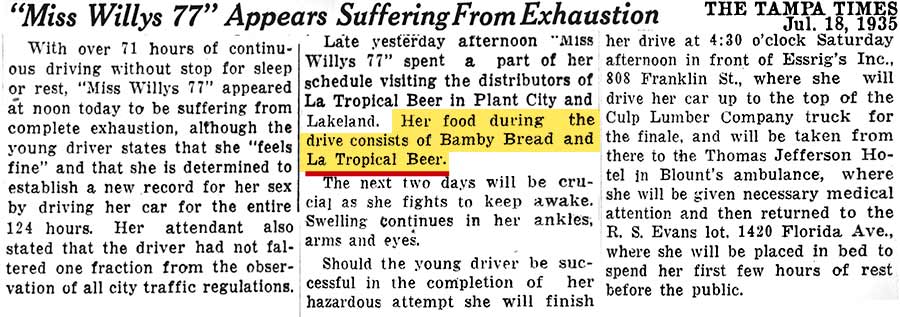
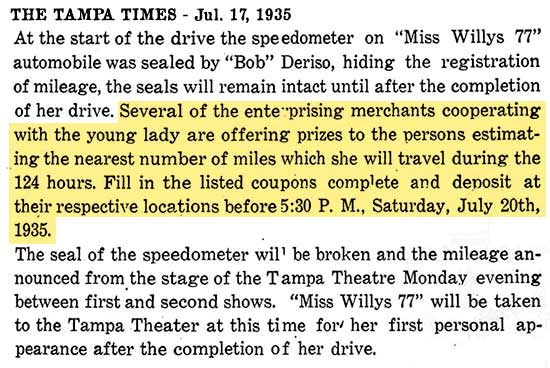
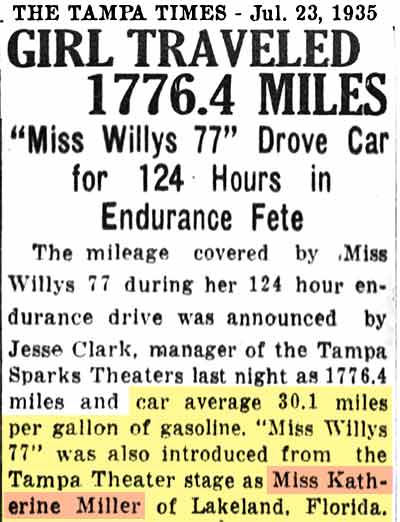
See
the rest of this ad which shows all her sponsors and the various prizes.
Each sponsor had their own prize and their own entry
form to fill out and turn in at their business.
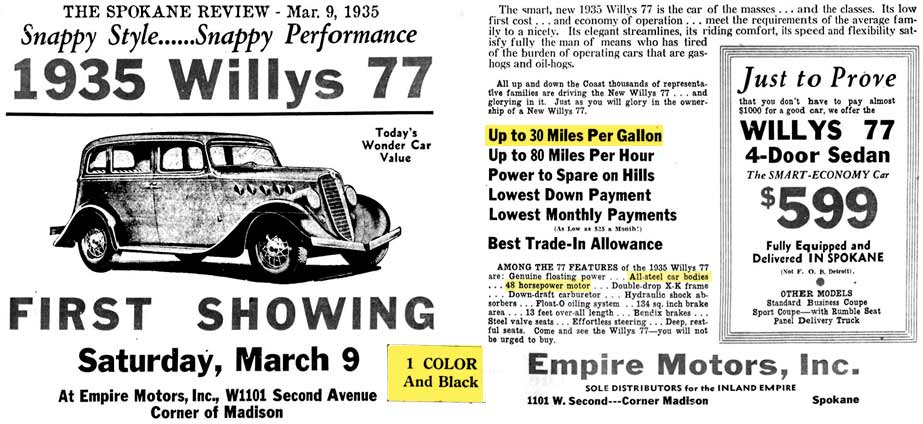
There were only three ads
for the 1935 Willys 77 in the Tampa newspapers, they looked like this
one:
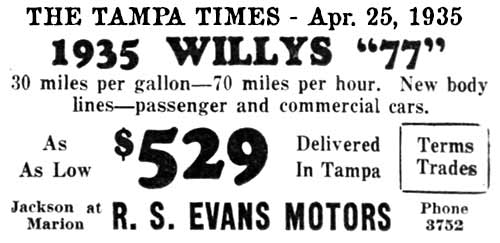
Miss Willys 77 and the contest got all the press.
|
FRECKLES, WORLD FAMOUS CHIMPANZEE, AT BOYD'S FOR
3 DAYS
Freckles was famous for appearances
in movies, his intellect, and physical stunts.
He was planned to demonstrate "Namello,
World Famous Auto Polish" at
Boyd's. (It's so
easy, a chimp can do it.)
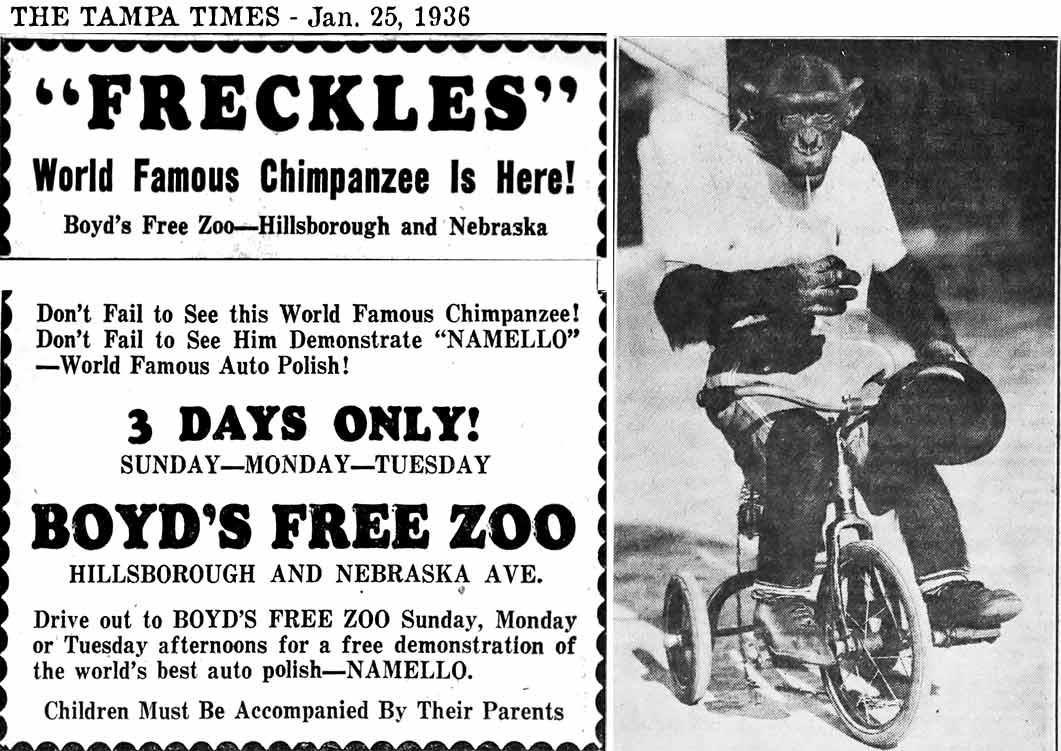 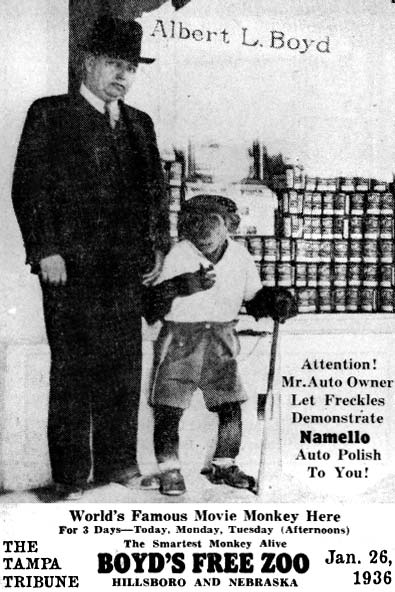
NOT THE FIRST TIME FRECKLES WAS IN TAMPA
|
|
Freckles was in Tampa making theater
performances in the summer of 1934.
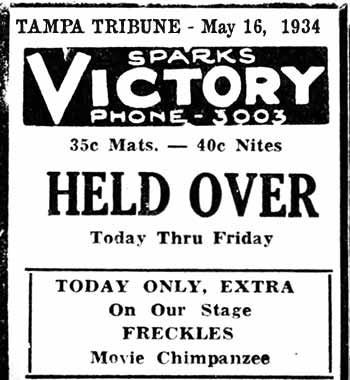
In
early 1936 Freckles was back in town for more
theater shows. The Seminole Theater had
Freckles "IN PERSON!" But is that possible
for a chimp? |
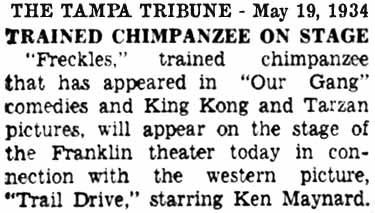
|
|
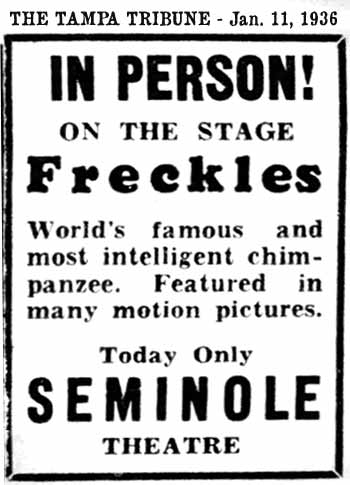 |
Boyd put Freckles to work.
The last week of January would have been the date of the R&F photos.
Robertson & Fresh photo courtesy of
USF Library Digital Collections
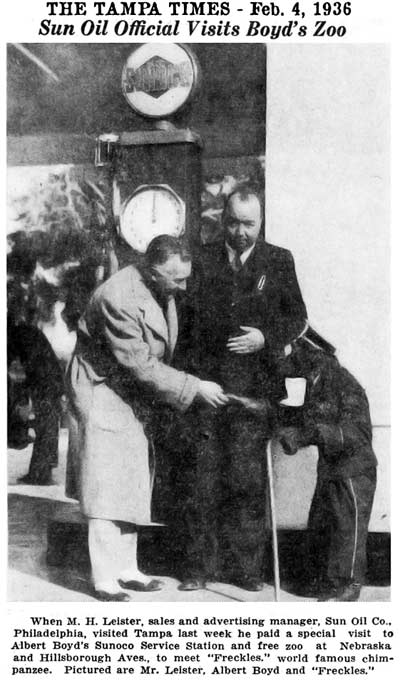

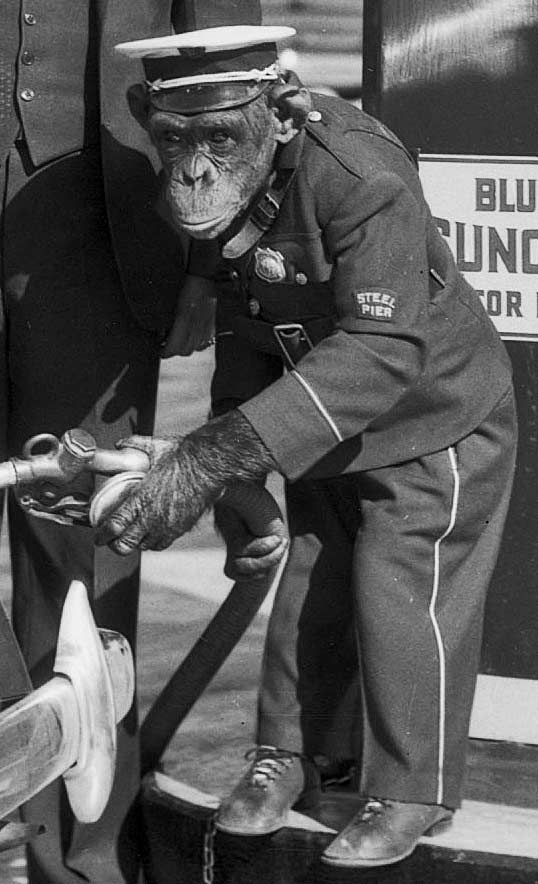
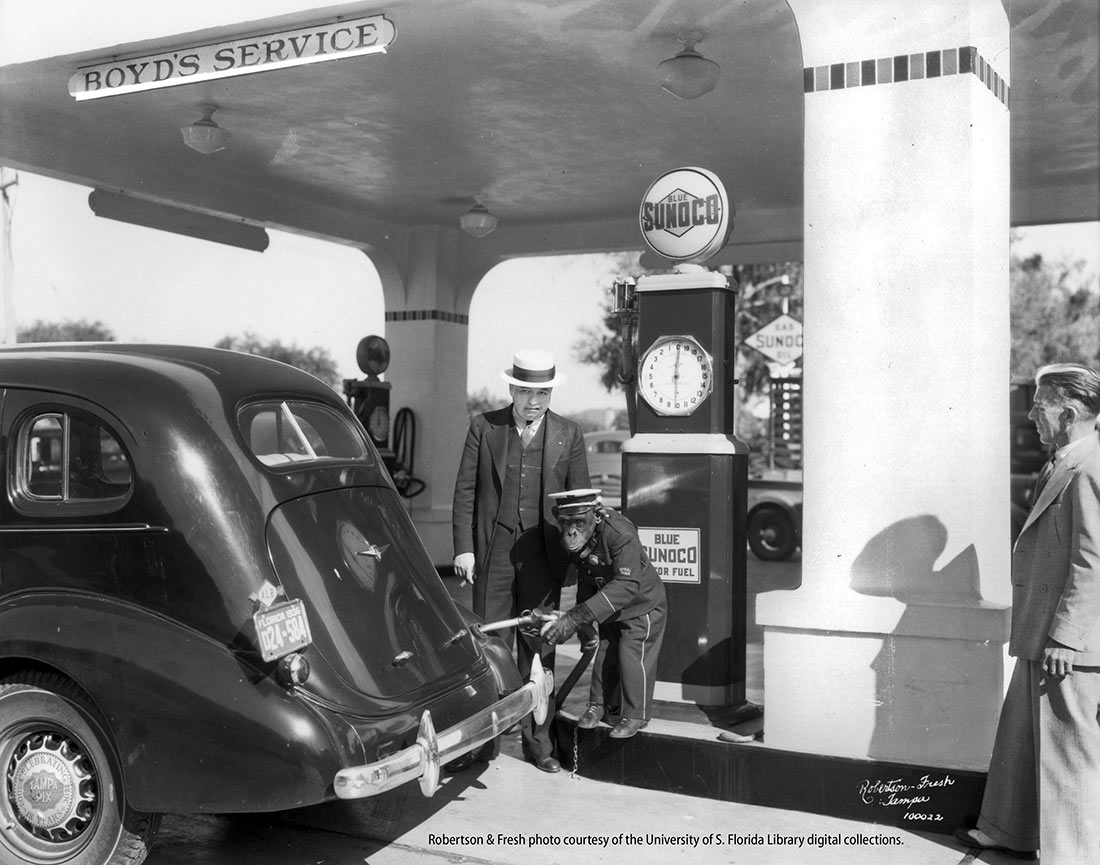
How many cigars does it take to ignite
gas fumes? Boyd gets gets dangerously close while
an executive from Sunoco stands back.
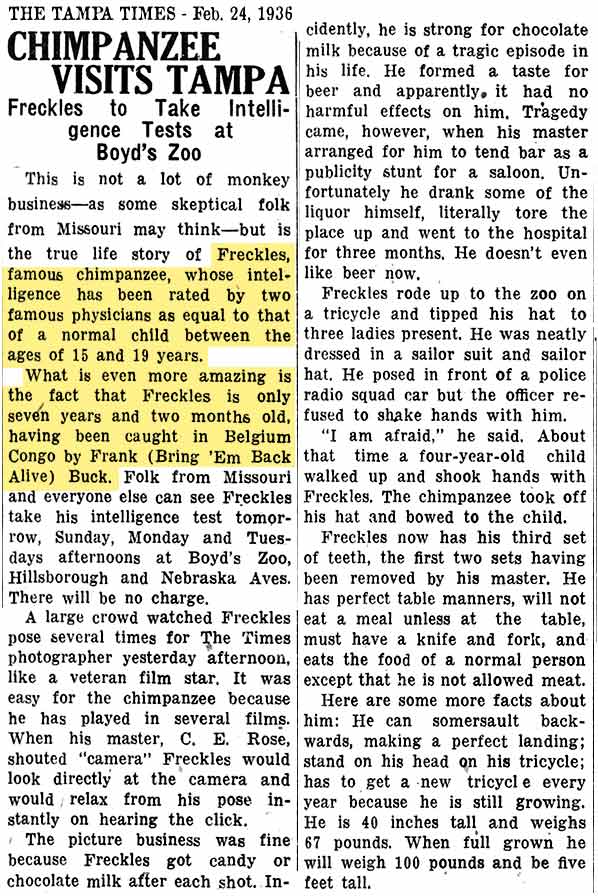
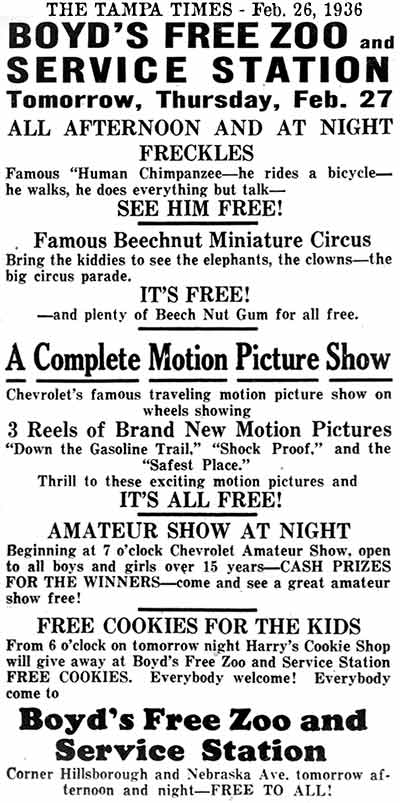
|
DEATH OF BUDDY, CANADIAN
BLACK BEAR - JUNE 19, 1936 |
|
Boyd acquired Buddy, a little Canadian
black bear, "several months ago" when he was left there by Royal
American Shows while they went up north. His thick fur is
described as an asset which came in handy up in Canada, but in a
climate such as Tampa, not so much. "But he was ill at times, and
despite medicine and the best kind of treatment..." Some thought
it was the heat, others thought it was his
"constitution." No article was found regarding the
circumstances of his acquisition.
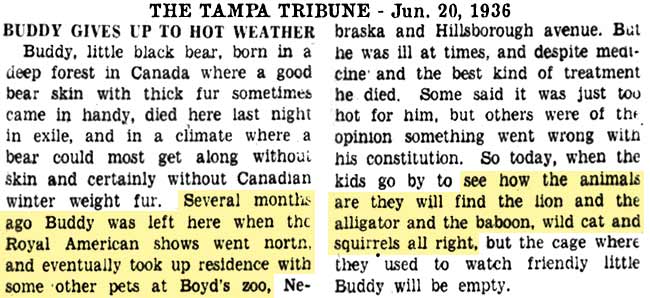
A lion, alligator, baboon, wild cat and
squirrels are mentioned.
BOYD'S ZOO FEATURES DEAD FISH - APRIL 6, 1936
Okay, so this wasn't a zoo
exhibit, but this was great publicity for Boyd. So much so that he
had Robertson & Fresh photography come out and take pictures of the
haul.
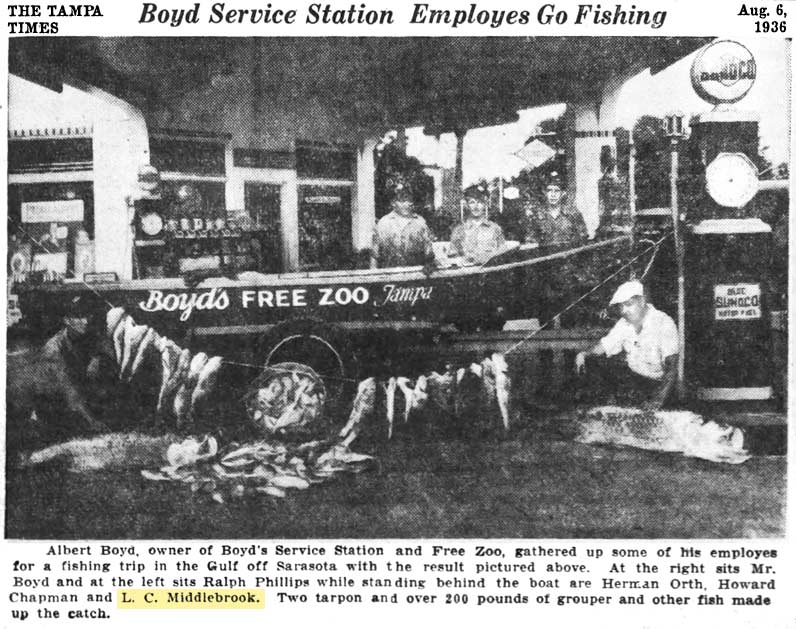 |
Robertson & Fresh
photo courtesy of the University of S. Fla. Library digital collections
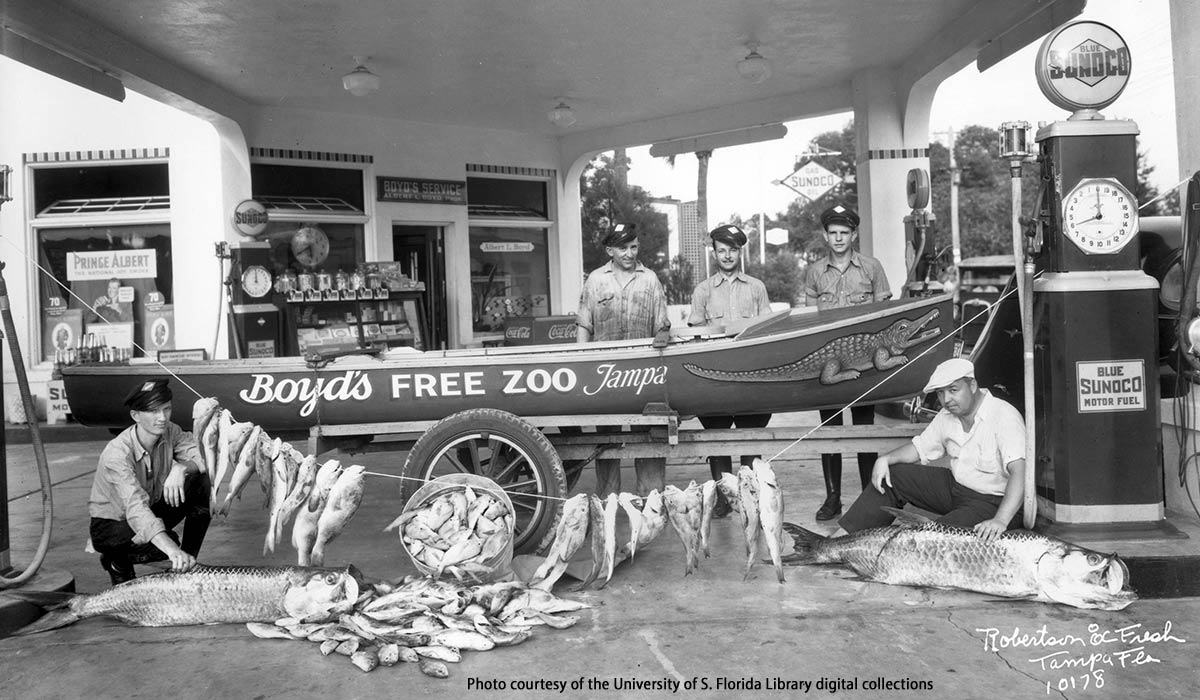
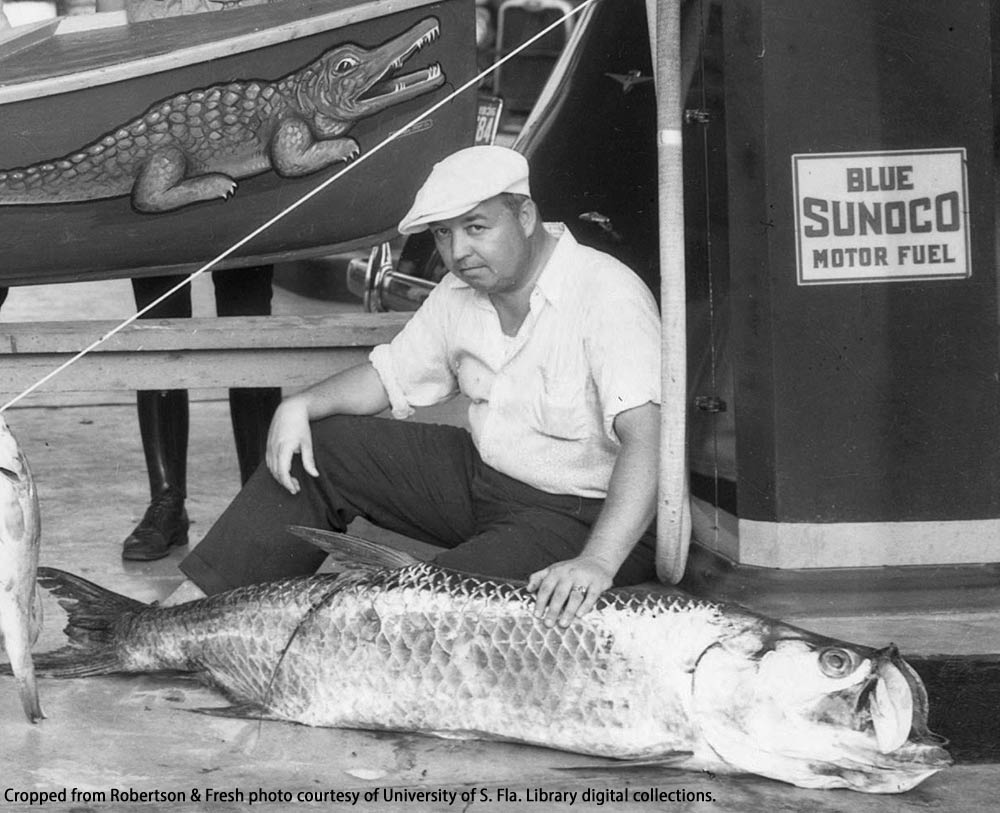
Albert Boyd (the one
with the hat.)
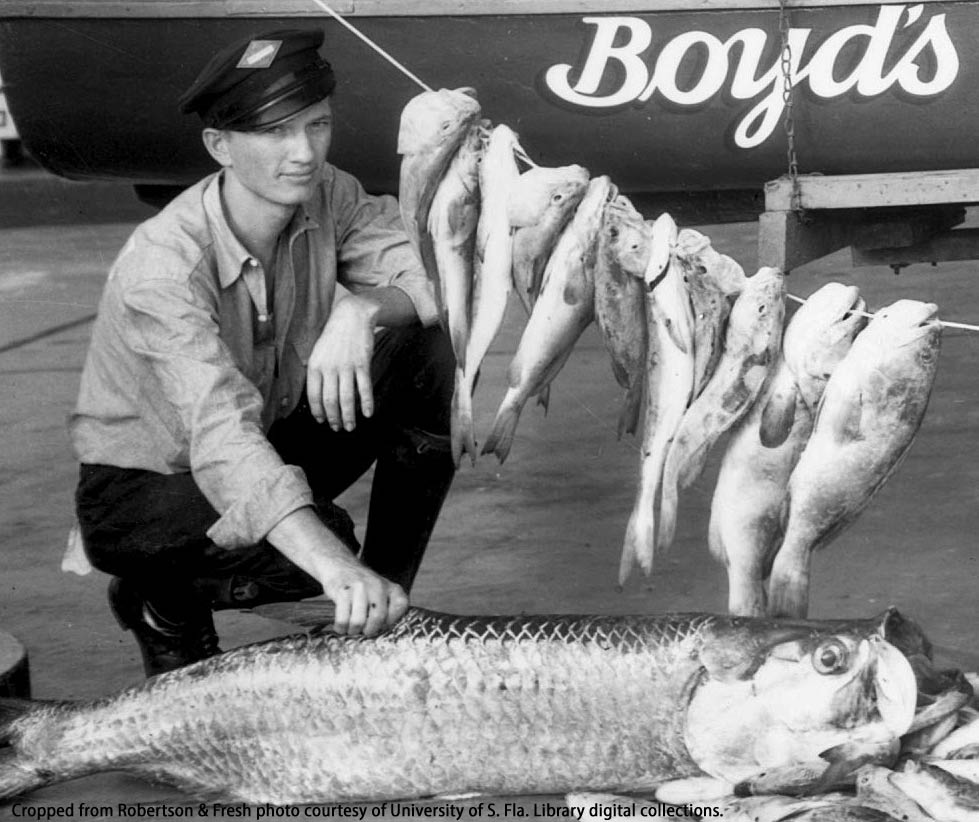
Ralph Phillips (on
the left.)
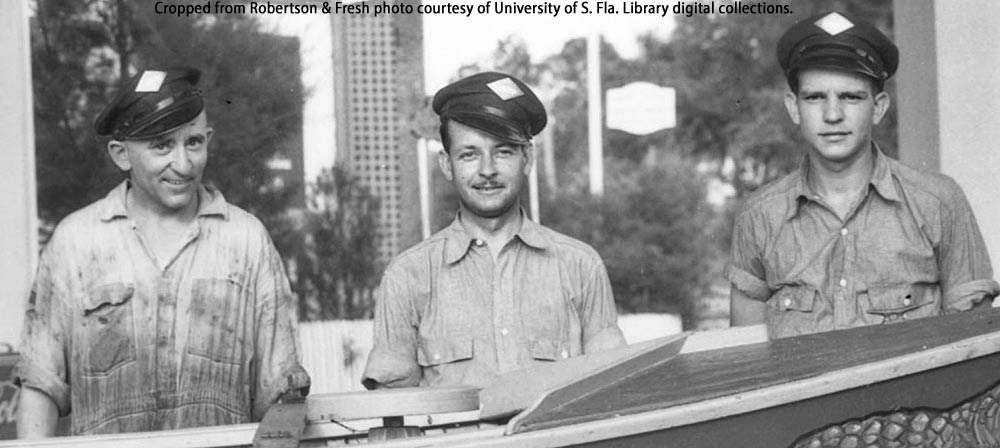
L to R: Herman Orth,
Howard Chapman, L. C. Middlebrook (Boyd's bro-in-law).
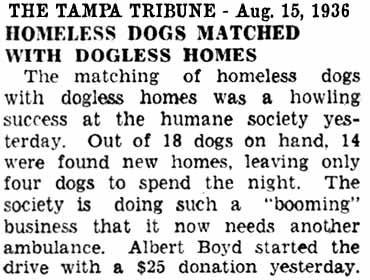
Aug. 15, 1936 - The Tribune
touted the success of the humane society's campaign to match homeless
dogs with dogless homes. Of 18 dogs, 14 were found new homes
The society started another campaign, this one to raise funds for an
ambulance. Boyd kick-started the drive by donating $25.*
*In 1934, the
country was in the midst of the great depression, and $25 in 1936 would
have been like $477 to us today. (U.S.
Dept. of Labor Statistics - CPI Inflation Calculator)
BOYD'S CELEBRATES THIRD ANNIVERSARY
This article below is the
source
of establishing Boyd's opening date.
Boyd threw a big, free
party on Oct. 17, 1936 to celebrate the station's 3rd anniversary.
He wanted all Tampans to visit and bring their children.
There would be souvenirs for them, Beechnut gum, Tom's peanuts and
Harry's cookies, all free. Boyd's zoo had become a Tampa
institution by this time, developed in 3 years. It gained so much
attention in his backyard that he moved it to the new modern station in
1933. It was constantly being enlarged, and at this point had
Beauty the lion, Jimmy the baboon, plus a dozen other members of the
monkey tribe, Bozo, the 12-foot long granddaddy alligator and several
hundred of his descendants ranging from 6 inches to 8 feet long.
There was a Gila monster, a beautiful egret with gorgeous plumes; Buddy
the spider monkey, Sam the white albino raccoon, and many species of
birds including an eagle and an owl. A nocturnal "Mexican night
monkey" sleeps all day and roams all night. The giant Rhesus
monkey was of the largest of his kind in captivity. There were
also rare tropical plants and shrubs, an attractive rock garden with a
large goldfish pool. The article ends with a description of his
auto service station amenities.
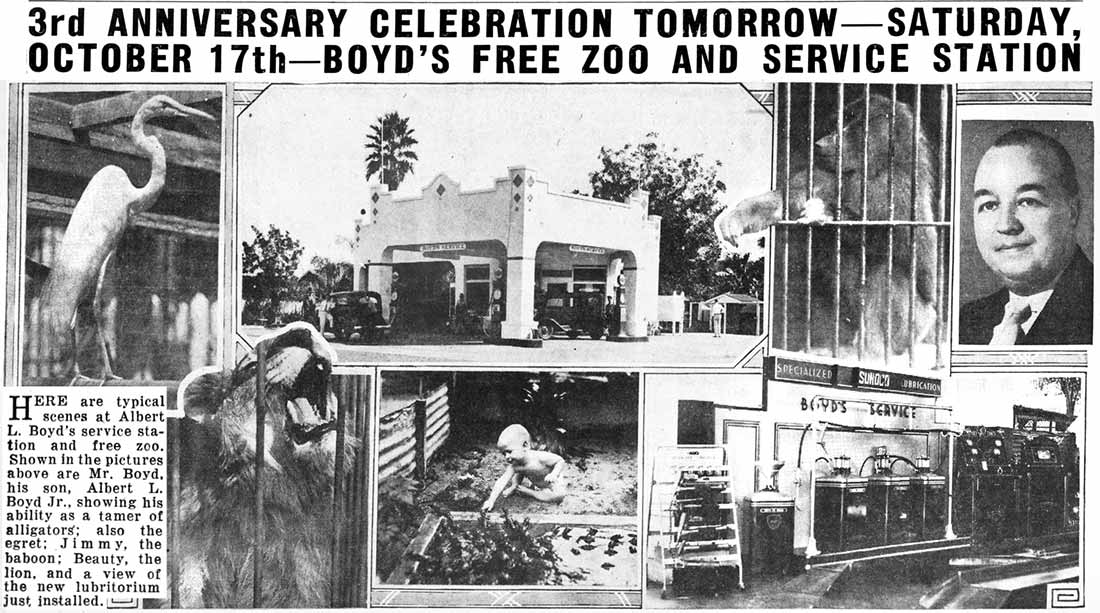

Another "exhibit" at Boyd's in
1936--Bozo, the 12-ft. long alligator.
Robertson & Fresh Photo courtesy of the
USF Library Digital Collections.
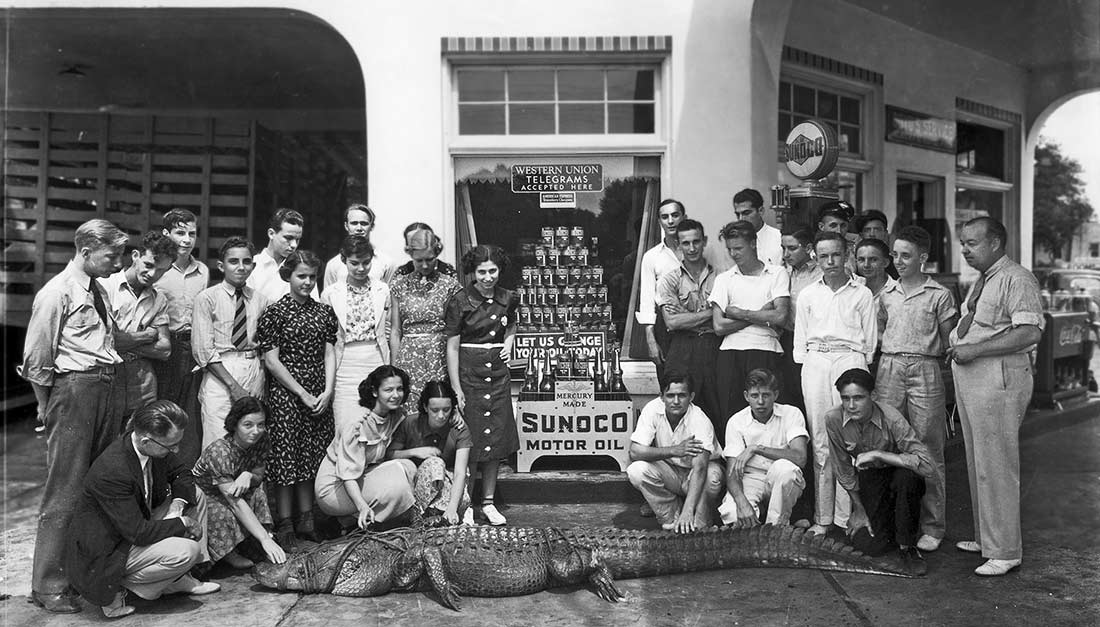
BEAUTY IS EUTHANIZED
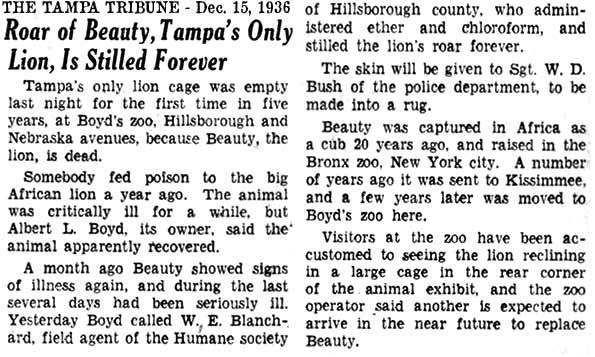 Just
three months after Boyd's big 3-year celebration,
in mid-Dec. 1936, Beauty was euthanized using ether and chloroform
because she had been seriously ill for several days. The illness
was thought to be the long-term effects of an intentional poisoning from
a year earlier. At that time, it was thought that she had fully
recovered. But a month ago, she began showing signs of illness
again which worsened. Just
three months after Boyd's big 3-year celebration,
in mid-Dec. 1936, Beauty was euthanized using ether and chloroform
because she had been seriously ill for several days. The illness
was thought to be the long-term effects of an intentional poisoning from
a year earlier. At that time, it was thought that she had fully
recovered. But a month ago, she began showing signs of illness
again which worsened.
"Beauty was captured
in Africa as a cub 20 years ago (1916) and raised in the Bronx zoo in
NYC. A number of years ago it was sent to Kissimmee, and a few
years later was moved to Boyd's zoo here."
Nothing could be found
regarding Beauty being sick or poisoned in 1935 or 1934. There are
articles and ads that mention her being at the zoo, but no mention of an
illness. Also, nothing concerning her life before she came to Boyd's could be
located.
HAIL, CAESAR
Within a few weeks, Boyd
had another African lion. Caesar was 18 months old and unusually
large for his age. He was in excellent health, and "promises to
live to a ripe old age." Below, Caesar can be seen behind
bars, as well as chained. His clawing may be a sign that he's not
accustomed to being behind bars.
|
| Caesar had no
mane yet, as male lions don't begin to grow one
until they are around two years old when they
begin to mature. |
MEET CLARENCE CHAMBERLIN AT BOYD'S
Clarence Duncan
Chamberlin (1893 – 1976) was an American pioneer
of aviation, being the second man to pilot a
fixed-wing aircraft across the Atlantic Ocean
(Jun. 5, 1927) from New York to the European
mainland, while carrying the first transatlantic
passenger. (Wikipedia)
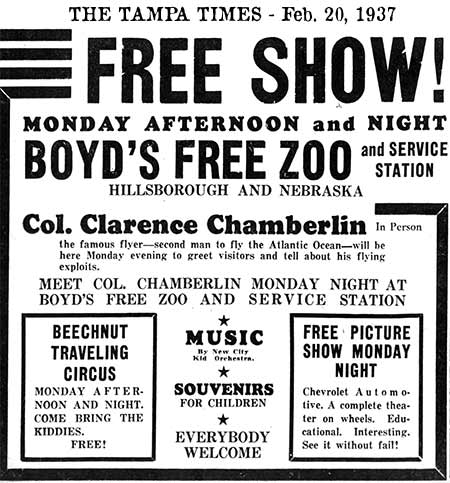 |
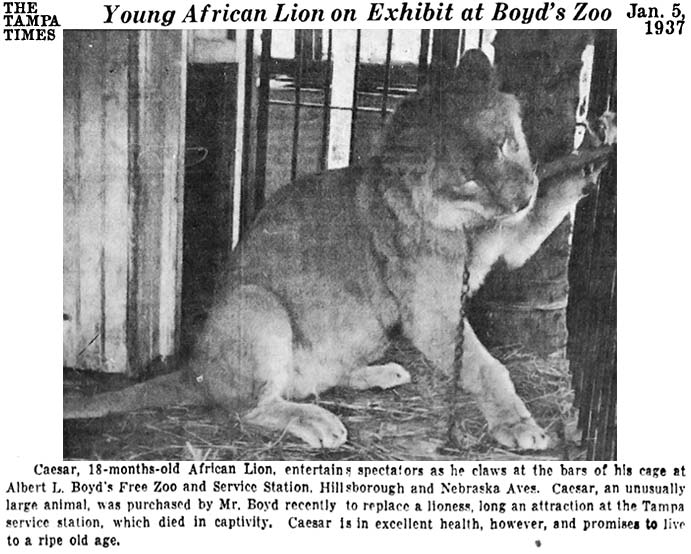 |
1927 photo of Clarence Chamberlin
shaking hands with Charles A. Lindbergh with Richard Byrd in center,
and the Spirit of Louis behind them
courtesy of Library of Congress.
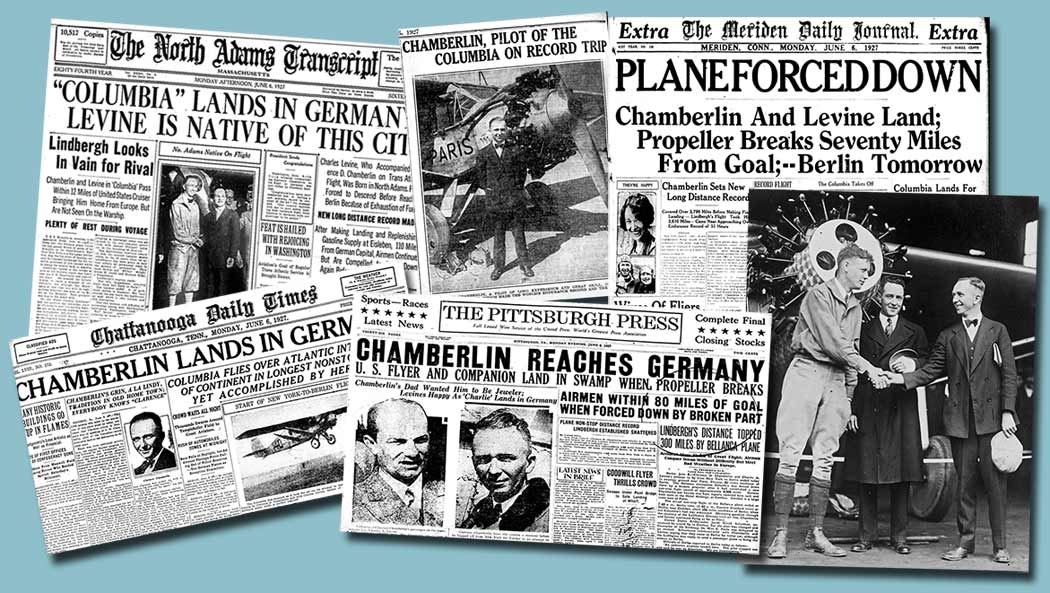
|
GATOR MAIL
A boy in Bellevue, Washington, sent Mayor
Chancey 25 cents and a note asking that an alligator be sent to him.
The boy had knowledge that they were for sale on the streets of Tampa
for that amount. Albert Boyd donated the baby gator free of
charge, and provided detailed instructions on how to care for it.
This was all sent to the boy along with his quarter. Boyd
got a letter from the boy on Mar. 15 saying he had built a pen for the
gator and was following his instructions, and now asked for literature
about Tampa's zoo and more info on how to care for and feed the gator.
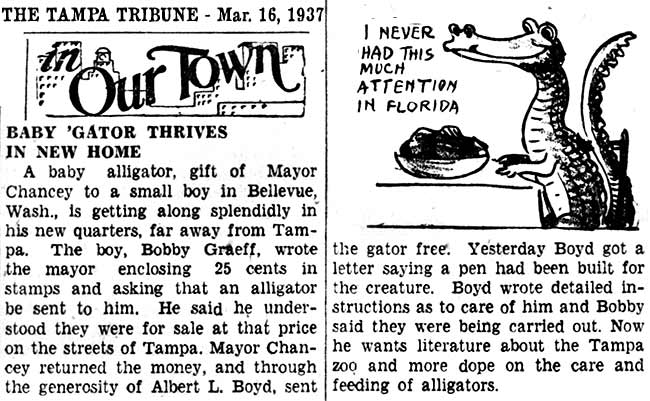 |
Albert Boyd and three
other Tampa businessmen got birthday greetings from the Times.
Albert was 39 in 1937.
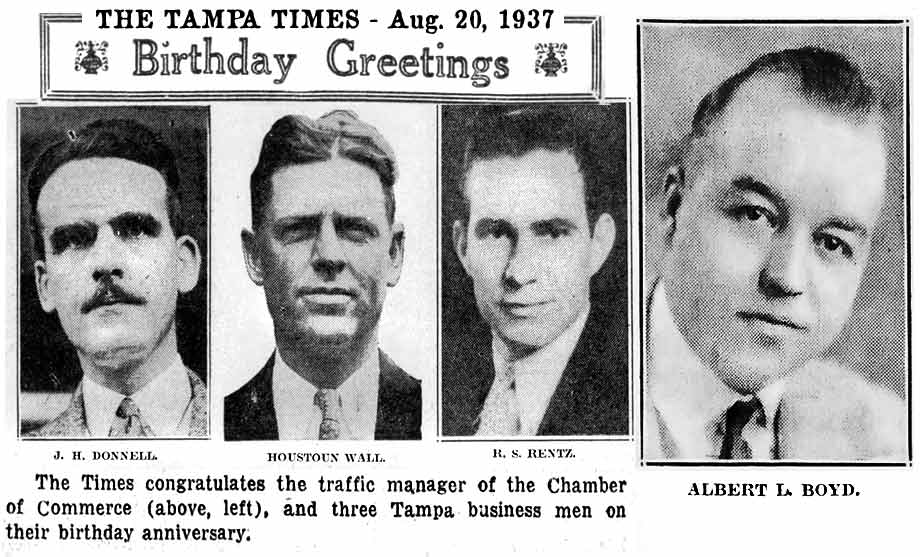
Al Boyd buying air mail stamps to send an alligator to Pres. Roosevelt.
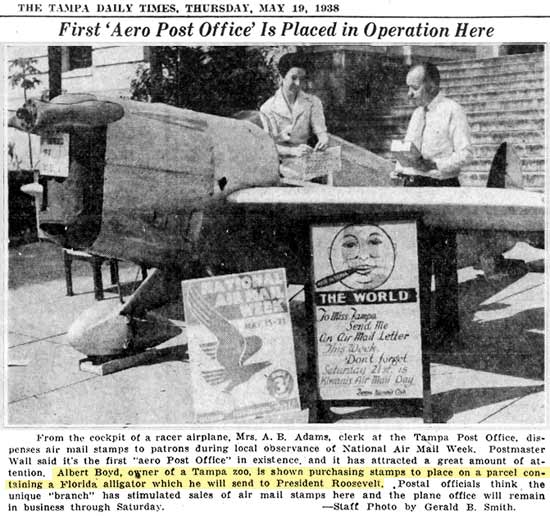
|
|
In late Nov. 1937,
Slover's pony track relocated to Boyd's. |
BOYD INVITES CHILDREN |
|
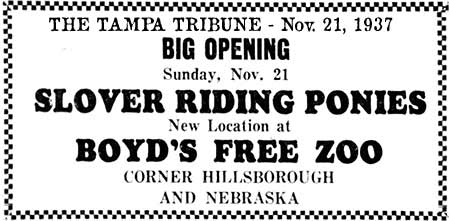 |
On
Dec. 29, 1937, seventy-five children from the
Children's Home were treated to a program at
Boyd's zoo, which included pony rides, a trip
through an educational trailer, a tour of the
zoo and gifts for every child.
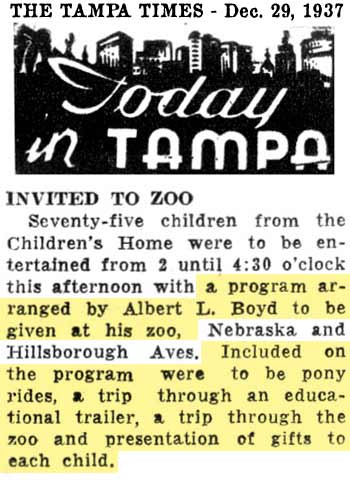 |
|
Slover's pony
track was previously located on the 4400 block
of Florida Avenue.
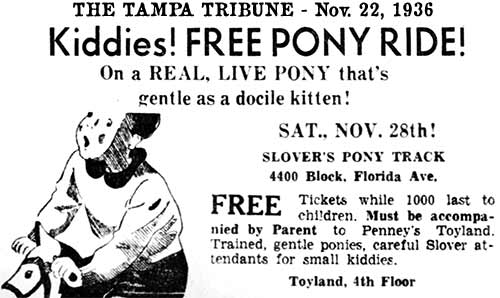
|
| |
|
BUFFALO AVE. SCHOOL STUDENTS TREATED TO PROGRAM AT BOYD'S
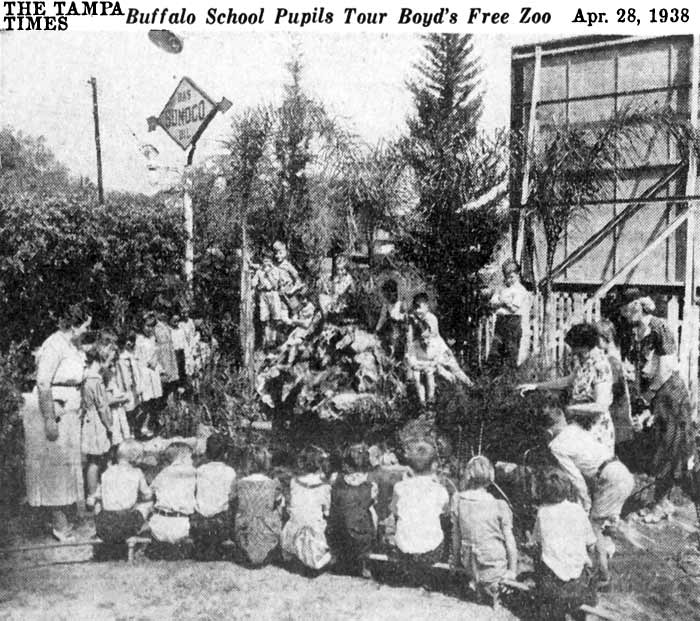

| |
NOISE AND ODOR COMPLAINTS BY
NEIGHBORS
By May 1938, Boyd's
collection included the lion, a baboon, an ape, a Gila monster, more
than 100 gators, over 100 chattering birds and various other beasts.
Boyd's neighbors had had enough and complained about the animal noise,
especially the lion's roaring, and the unsanitary conditions. One
neighbor, A. A. Hamilton, with the backing of sixty others, filed a
lawsuit claiming the lion's roar was keeping them awake at night and
could be heard from half a mile away. |
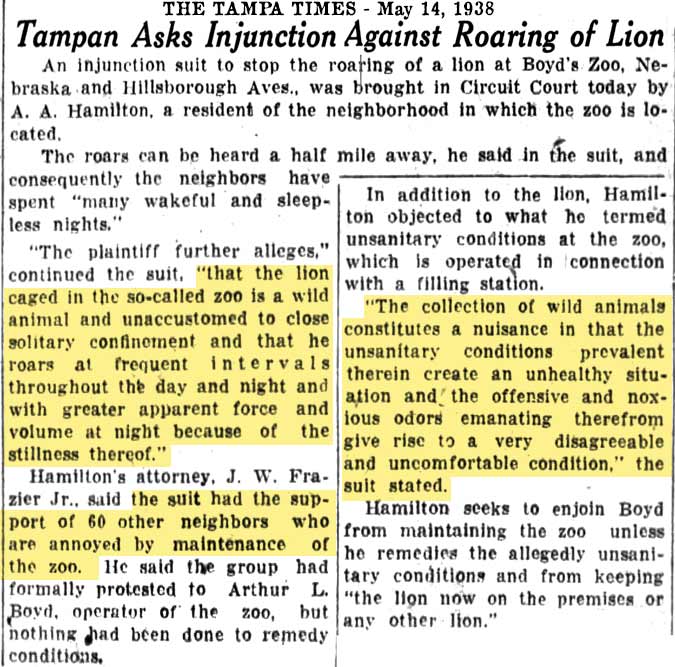 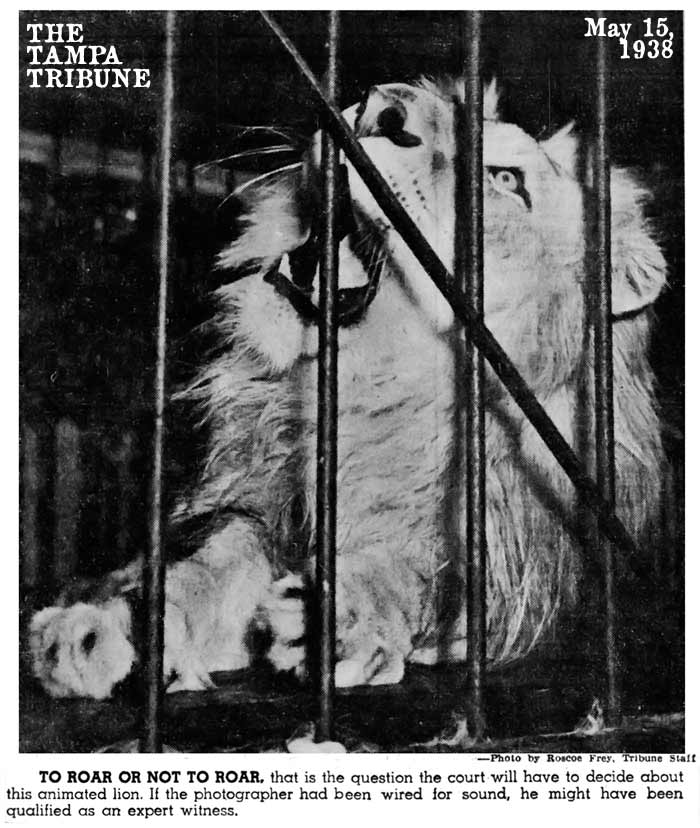
Assuming this is Caesar, he would have
been around three years old by this time and appears to have grown quite a
mane.
No article has been found indicating that Caesar was no longer at the
zoo nor was replaced.
| In the lawsuit, the primary plaintiff, A.
A. Hamilton, claimed that as a result of sleepless nights, his health
was "severely injured through the occurrence of general nervousness and
loss of weight." The suit also claimed that a possible reason for
the lion's behavior was that it "is a wild animal and unaccustomed
to close solitary confinement." The article also states that
the zoo required better sanitation facilities, which were now "barely
tolerable to those in the immediate proximity." This was
probably a reference to odors.
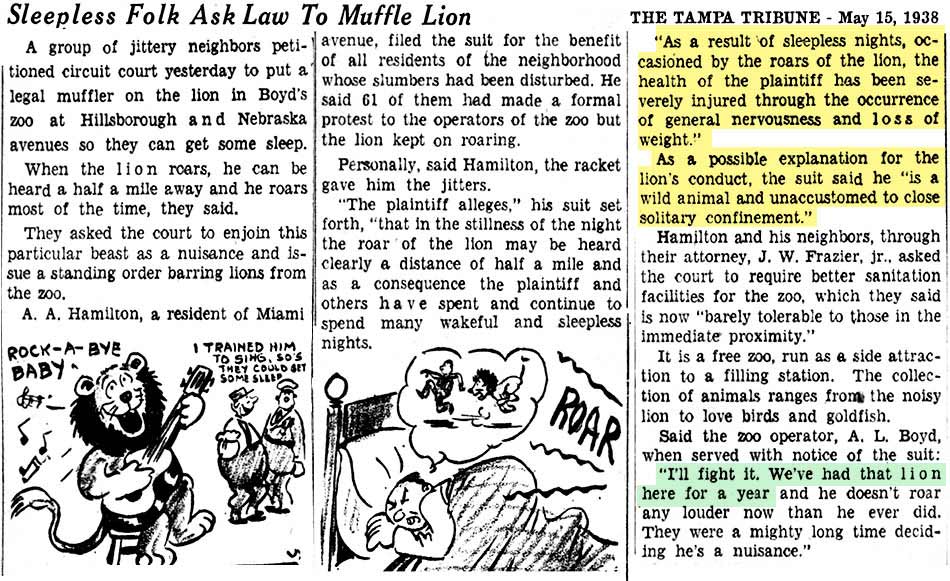 |
BOYD DEFENDS HIS ZOO
Boyd defended his zoo as
highly beneficial to the city in terms of tourism, national attention
and education for school children. He said he had a lion at the
zoo for five years and it didn't roar any louder now than did any of the
the others at any time. He felt the plaintiffs were singling him
out because neighbors of the fair grounds (which was then located
between Grand Central Ave. & Cass St. at North Blvd.) never complained
about the lions roaring from the Royal American Shows where were on site
for several months of every year.
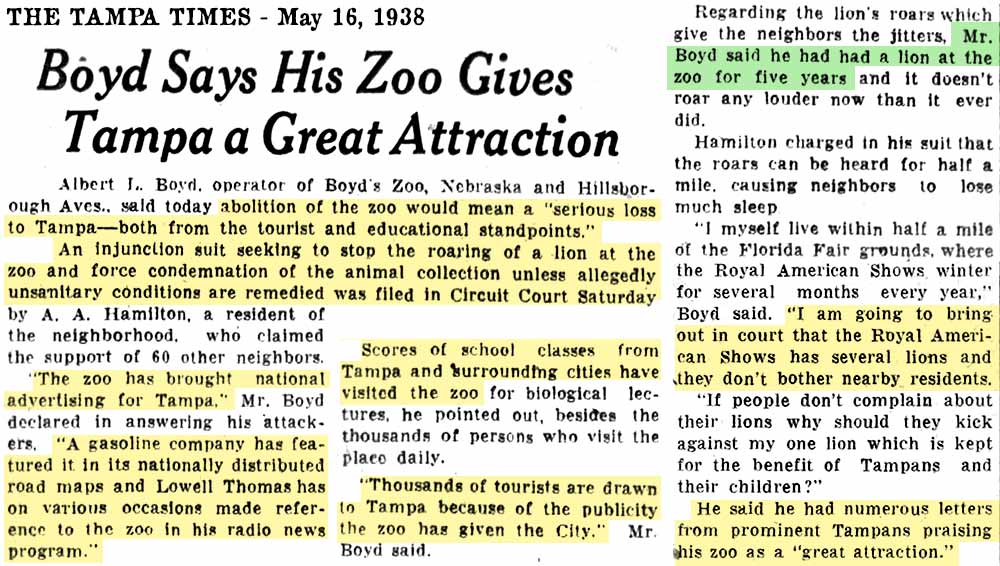
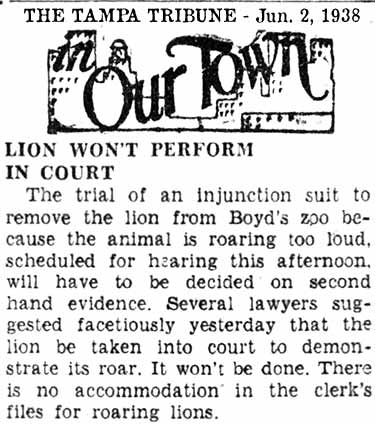 |
Before the hearing, several
lawyers joked that the lion would need to appear in court so the judge
could hear him roar, but that wasn't going to happen.
|
OUT-OF-COURT AGREEMENT REACHED
A settlement was reached
before the hearing with Boyd agreeing to move the zoo to a more remote
location. Boyd planned to move the zoo to Memorial Hwy near West Columbus Drive. Today this area
is part of Tampa International Airport's runways. Boyd thought the lion
and the others would like it better more out in the open, and he could
fix it up and enlarge the place to make it a better attraction.
But the lion isn't named
Caesar, it's referred to as "Leo." In the May 15 article
about the lawsuit, the lion's
name isn't mentioned, but Boyd said he's had the lion for a year, which
would indicate he acquired it around May of 1937. Caesar was
acquired around Dec. of 1936 or Jan. of 1937. No further articles
could be located concerning any of Boyd's lions or his zoo, besides
these presented here from the time he acquired Caesar to the time of
this lawsuit.
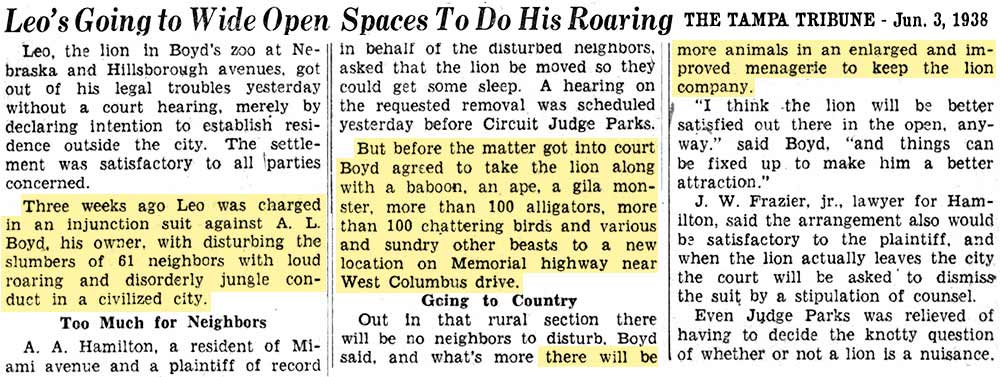 |
| |
|
|
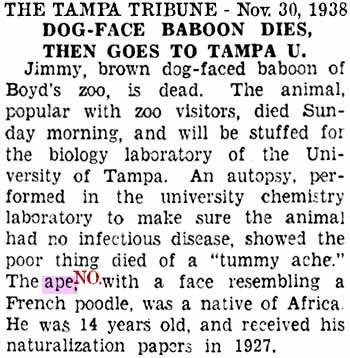 |
DEATH OF JIMMY THE BABOON
The
14 year old "dog-faced" baboon named Jimmy died
in late Nov. 1938. An autopsy revealed he
died of a "tummy ache." It was said he had
a face like a French poodle, and was brought to
the states in 1927.
Baboons are NOT apes, they are monkeys.
They have a tail. A face resembling a dog
is common to all baboons. |
SIDNEY'S
GREAT ADVENTURE
On the
evening of Nov. 26, 1939, Sidney, "the tame wildcat"
from Boyd's zoo, escaped from a car he was riding in
when it was involved in an accident at Albany and Swann
Ave. The article reveals that Sidney was only being exhibited at
Boyd's, but Boyd did not own him. Its owner, J. D.
Waddell, was driving Sidney on a "Sunday outing" when
the accident occurred. The cat leaped from the
back seat of the wrecked car, cut across a vacant lot
and disappeared . Waddell, of 1311 Swann Ave, was
arrested and charged with drunken driving. He
offered a $25 reward for live return of the cat.
The article says that "The cat, which has been exhibited
at Boyd's zoo at Nebraska and Hillsborough Avenues, was uncaged and untied in the rear of the car. So
apparently, as of this time, Boyd had not moved his zoo.
Perhaps he changed his mind and got rid of Leo and
cleaned up the place instead. No lion by any name
is ever mentioned at Boyd's in articles after the
out-of-court settlement.
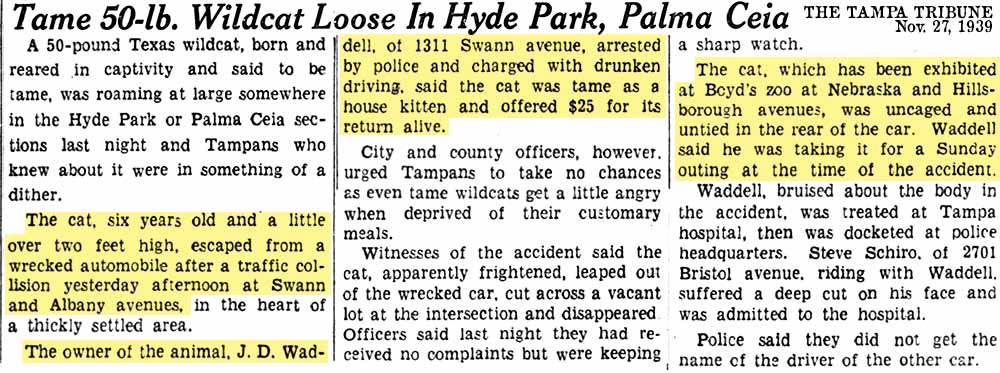
SIDNEY
FOUND AND RETURNED, UNHARMED
The next
day, Sidney was found curled up in the sink of a
washroom in a vacant building on S. Albany Ave.
The reward went to F.B. Cramer, Jr. and his father, who
both went out on the hunt looking for him. The
details of his peaceful "capture" are revealed in this
article.
But the
"wild" in wildcat was made evident in Sidney when Boyd
arrived and tried to take him out of the car he was held
in. "Excitement of so many people around made the
tame wildcat wild." (Or maybe it was the sight of
Boyd because he knew it mean his freedom was over.)
Boyd said "his eyes are too green, when they turn that
color, it's not the best idea to mess with him."
Once Sidney
cooled off, he was put in his cage, but not before
swiping at his attendant and slashing his right wrist.
It was said
that Sidney (a.k.a. "Bob" because of his tail) was known
for going on trips with Waddell on his travels around
the state and staying in hotels without bothering
anyone. But Sidney's bob tail and size have given
lots of people shaky moments.
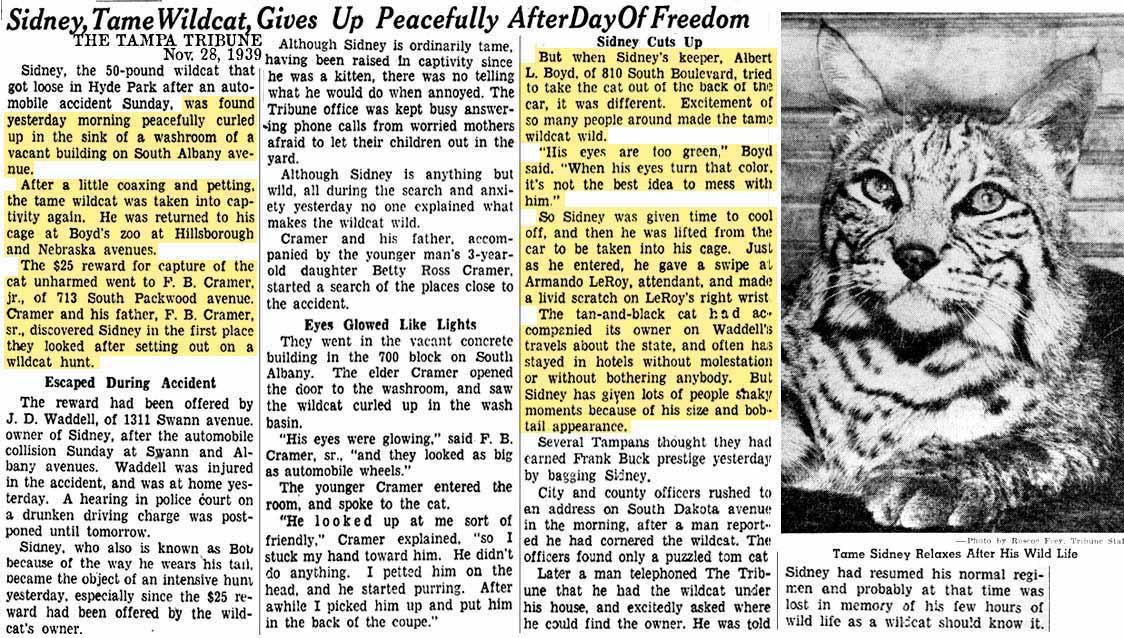
The Tampa Times covered
the same event and calls Sidney by his alias: BOB.
The article reveals some details not mention in the
Tribune article. The Times' photo also features Bob's captor, so
you can see how big Bob really is compared to a man.
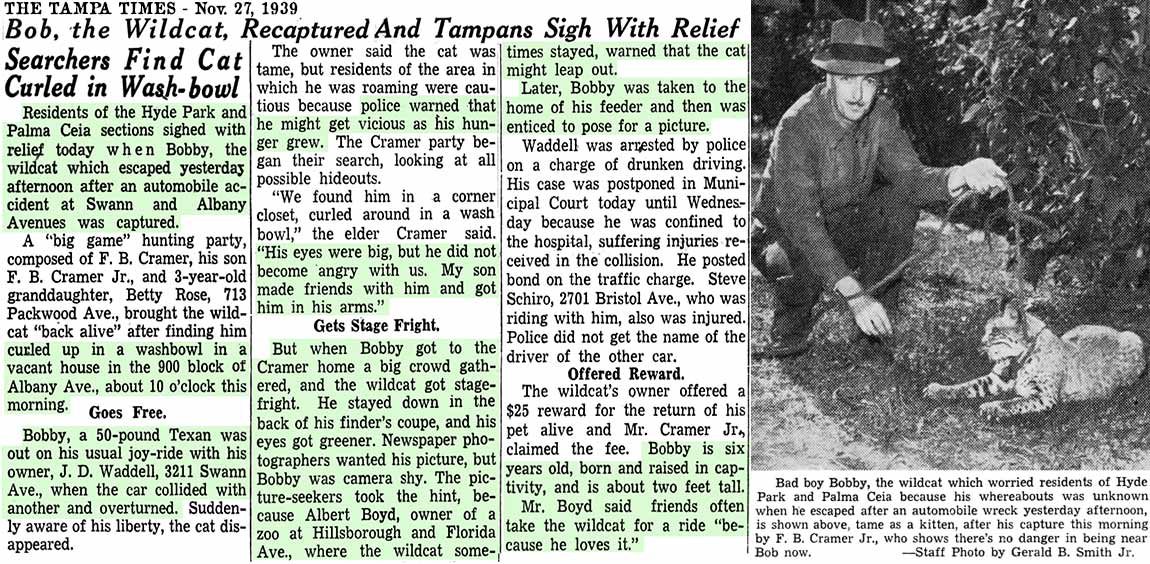
|
DEATH OF SIDNEY/BOB
About four
months after Sidney/Bob tasted freedom for a
day, he was was dead. The Tribune took
the opportunity to sensationalize Sidney's
moment in the limelight last November.
"The 50-pound
cat that had Hyde Park terrorized for 12
hours before he was found..."
Nothing more
is revealed about Sidney other than that he
"succumbed to an undiagnosed ailment in his
cage at Boyd's zoo, at Nebraska and
Hillsborough avenues. Apparently Boyd
never moved his zoo to Memorial Hwy &
Columbus Drive.
|
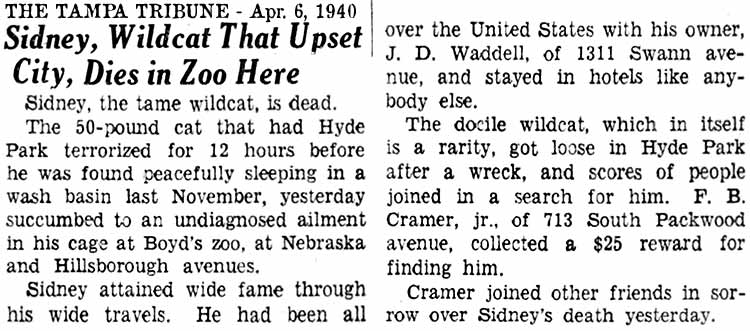 |
| |
|
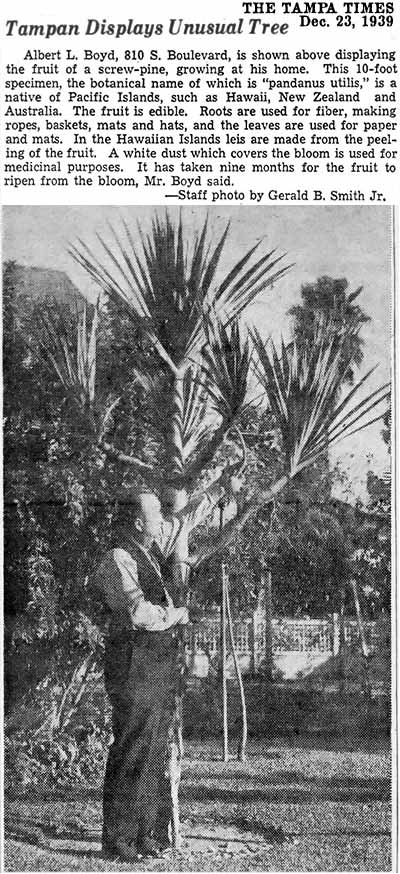 |
BOYD SPONSORS TRAINED ANIMAL SHOW AT HIS SUNOCO
STATION
Albert Boyd's fondness for animals was
well-known throughout Tampa, having participated
in many charitable events for the Humane
Society. On Dec. 18, 1940, he put on an
exhibition of trained animal acts in a tent set
up at his station at Hillsborough and Nebraska
Avenues.
A
Californian named Dan Riley was the trainer of
animals since he was nine years old; his act
featured two monkeys, a chimp, three goats, 18
dogs, a mule and a bear, all trained.
There was no admission fee, but donations would
be accepted and given to the Humane Society.
Boyd invited the youths at Mary Help of
Christians Orphanage to attend the show on
opening day.
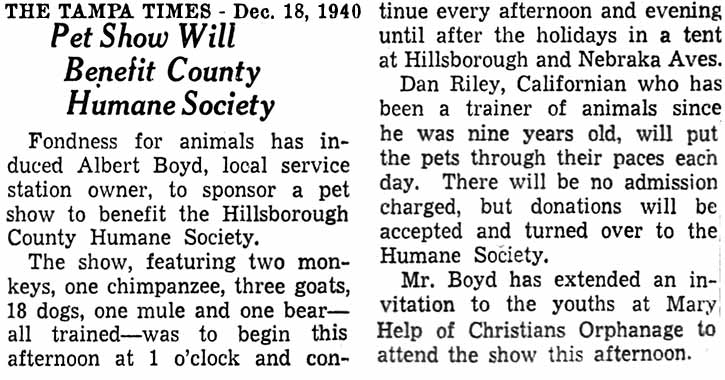
The "Screw Pine" isn't a pine tree at all, it's
a palm-like tree native to the tropics.
Often called pandanus palms, these plants are
not closely related to palm trees. Pandanus
trees are of cultural, health, and economic
importance in the Pacific, second only to the
coconut on atolls. (Wikipedia)
See more at University of Florida IFAS Extension
PANDANUS UTILIS |
| |
|
BOYD AS A U.S. NAVY RECRUITER
|
At the start of WWII,
Boyd became active as a volunteer Navy recruiter and was given an award of
merit by the Navy in early 1943.
In late Nov. 1942 over 1,200 Hillsborough
High School students saw the Navy films.
The films covered many phases of Navy life
in the Philippines and Hawaii before the
war, Naval Air Corps training, battle
maneuvers and practice, and far East Navy
stations.
Showings of the films could be arranged by
calling Boyd at his service station.
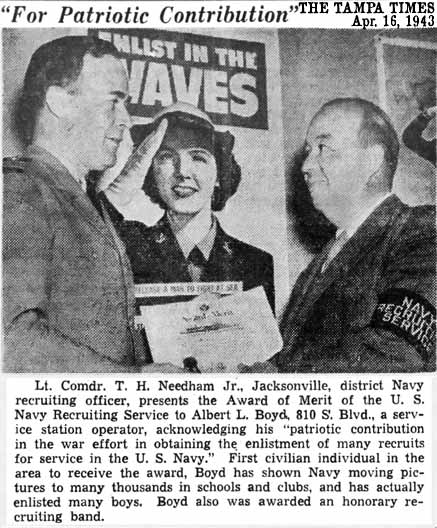
In
March 1943 Grand Ole Opry star Roy Acuff and
his troupe entertained troupes for two days
in Tampa. Al Boyd arranged for Acuff
to greet a group of Tampa orphans to be a
guest at the Opry matinee on March 31 to
meet Acuff and get his autograph. |
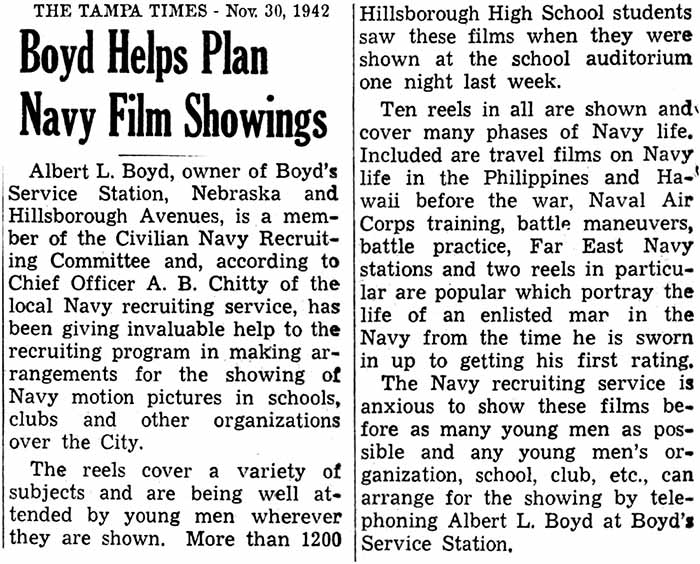
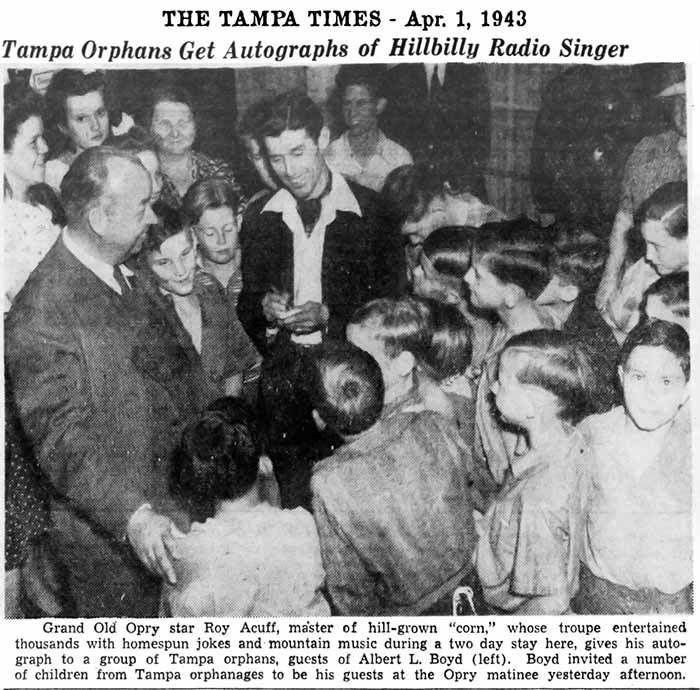 |
|
BOYD
ANNOUNCES HE WILL RUN FOR MAYOR OF TAMPA
In June 1943, Tampa attorney
Luthor Cobbey, county budget board member T.N. Henderson,
and Co. Commissioner Curtis Hixon announced their bid for
Mayor to succeed incumbent Robert Chancey. Albert Boyd
and attorney T. B. Castiglia had discussed running.
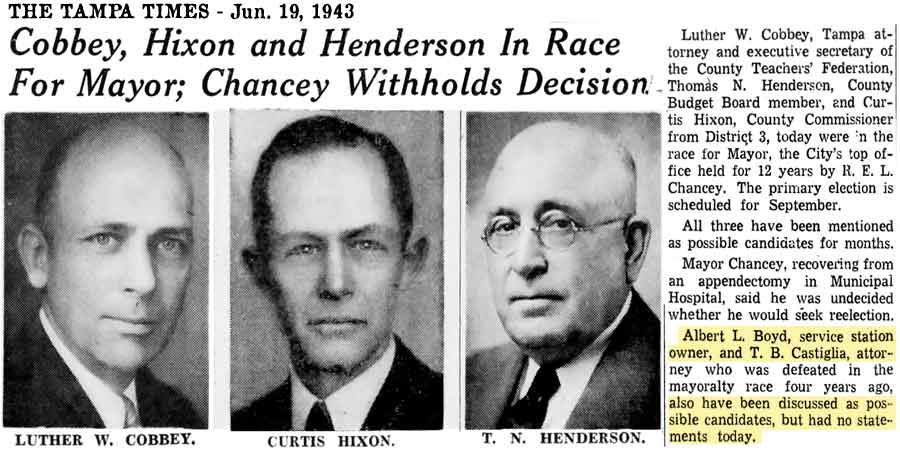
Boyd announced
his bid for mayor of Tampa on July 5, 1943. He was
strongly in favor of the development of the port of Tampa.
The article says he
came to Tampa 22 years ago, which puts his arrival at 1921.
An earlier article put his arrival at 1922. It also
claims he was in the filling station business for the last
18 years, putting the start of that occupation at 1925.
Ads in the 1925 newspapers show he was in the real estate
business at that time Evidence of his filling station
occupation comes with the 1929 Teapot Dome Texaco ad but it
could have been earlier.
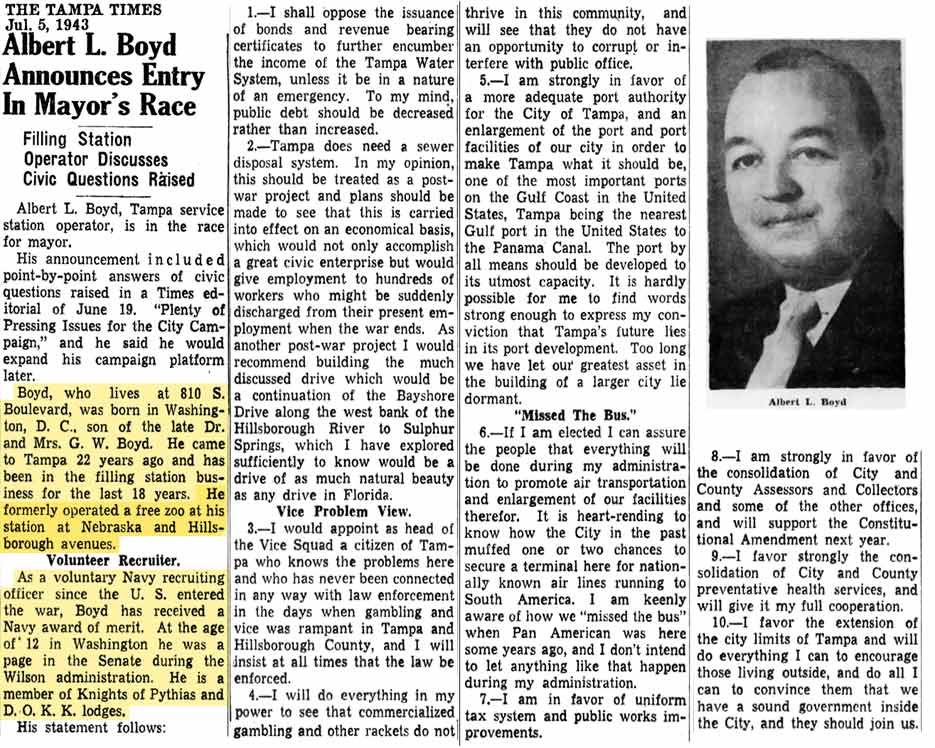
Notice he
is described as a "formerly operated a free zoo at his
station at Nebraska and Hillsborough Avenues."
|
Thomas Henderson
withdrew from the race on July 6, citing health
reasons due to a recent auto accident.
"...unless I could give it my best, I would not
want it." |
Mayor Chancey delayed announcing his candidacy,
but he was the first to put up the $650 fee,
which was 10% of what the mayor's salary was.
($650
in 1943 was like $9,976 would be to us today.) |
|
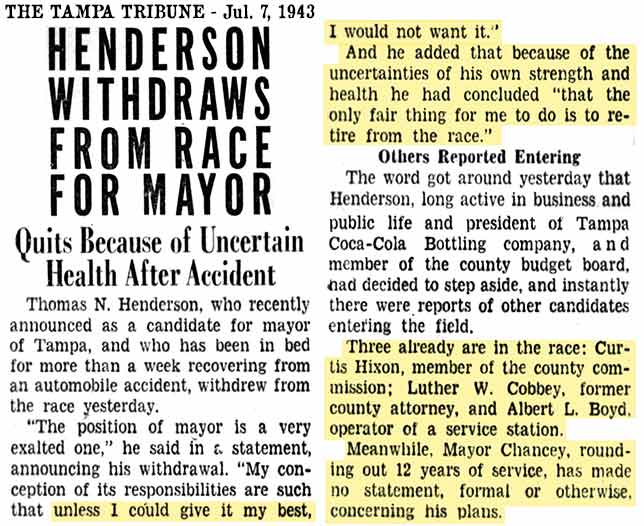 |
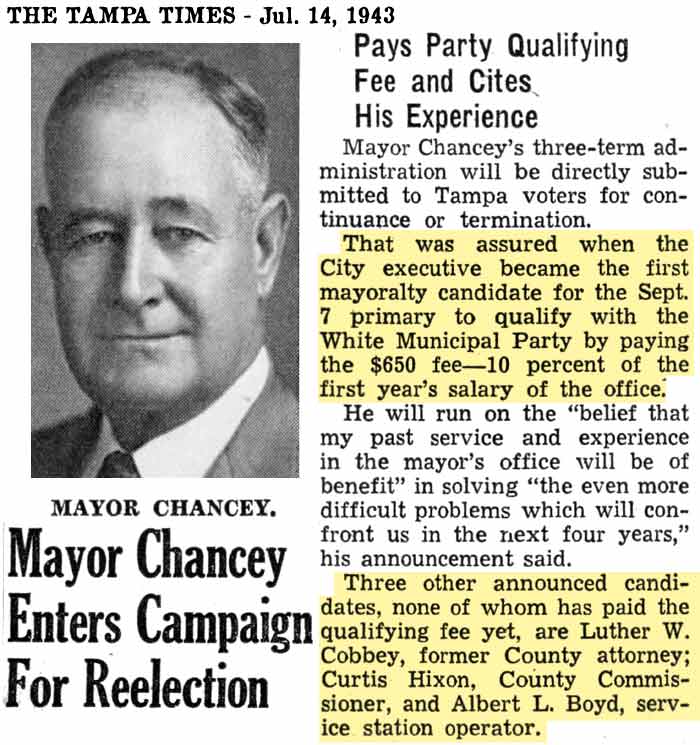 |
On Aug. 7, former judge Thomas Castiglia announced he would
run against Chancey for mayor...again.

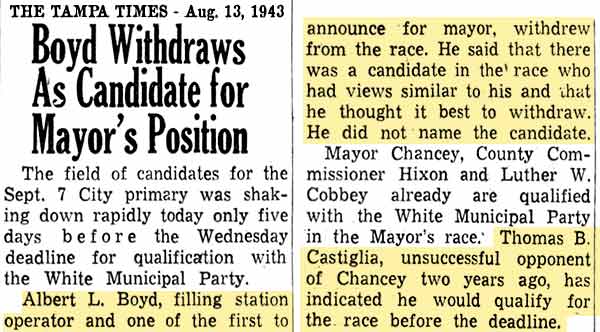 BOYD
WITHDRAWS AS CANDIDATE FOR MAYOR BOYD
WITHDRAWS AS CANDIDATE FOR MAYOR
On
Aug. 13, Albert Boyd withdrew from the race, stating that
one of the candidates had views similar to his and so
thought it best to withdraw. He didn't say who that
was. Castiglia announced on the 14th that he changed
his mind as well, and withdrew. Cobbey, Hixon
and Chancey had all paid their fees.
The election was held Sep. 7, with Hixon
taking 5,705 votes, Chancey with 5,088, and Cobbey 4,375.
A runoff election was held on Sep. 21 between
Chancey & Hixon, which of course the papers called "the
second primary" with Curtis Hixon being "nominated"
for mayor by a margin of 3,200 votes.
|
On Jan. 14, 1944,
Albert Boyd was named treasurer of the
Hillsborough Co. Humane Society to succeed T. S.
Newton. |
|
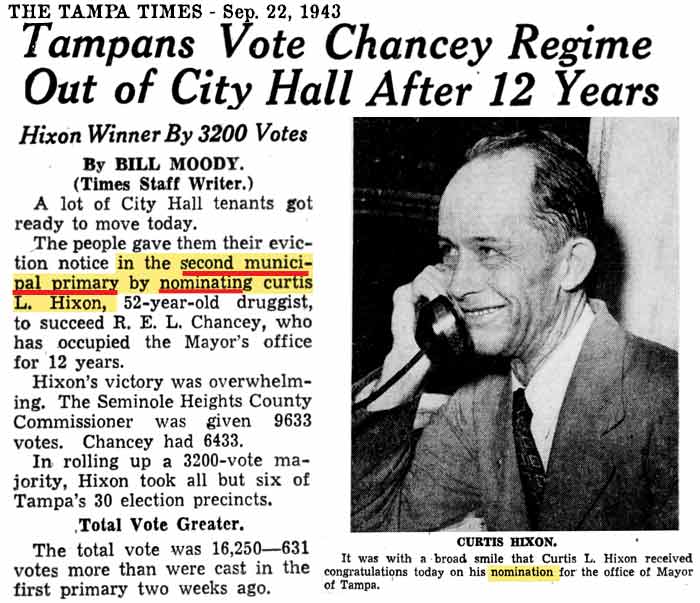 |
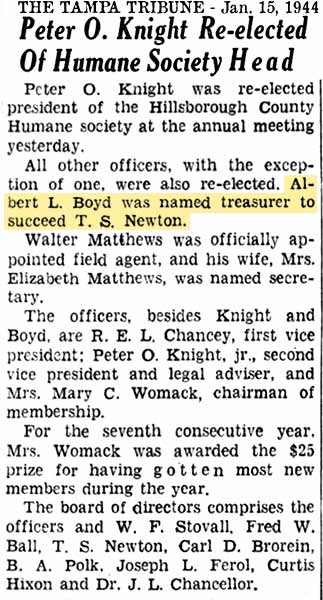 |
|
ALBERT BOYD NAMED HUMANE SOCIETY PRESIDENT, Jan.
1946
Every January the Humane Society of Hillsborough
County elected officers. In 1946, Albert
Boyd was chosen to succeed Peter O. Knight, and
Knight became an honorary president.
Knight was also one of the directors, as well as
his son, Peter O. Knight, Jr. who presided over
the meeting. Boyd, as retiring treasurer,
reported the total receipts for the year and the
total expenditures, the largest of which was for
a steel mesh fence around the property.
The article provides the cost of being a member,
as well as statistics on the animals. It
also states that the current ambulance will need
to be replaced this year.
Of particular interest is that the society had
two deer, Rosie Mae and Johnnie, both of which
are tame and like to be petted, "especially
if offered a cigarette. They like to eat
cigarettes."
|
|
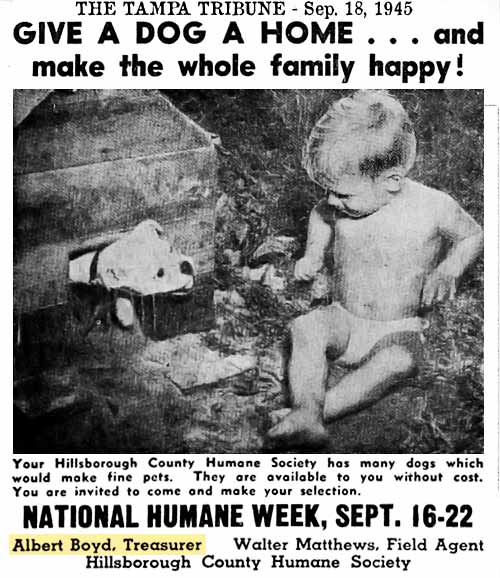 |
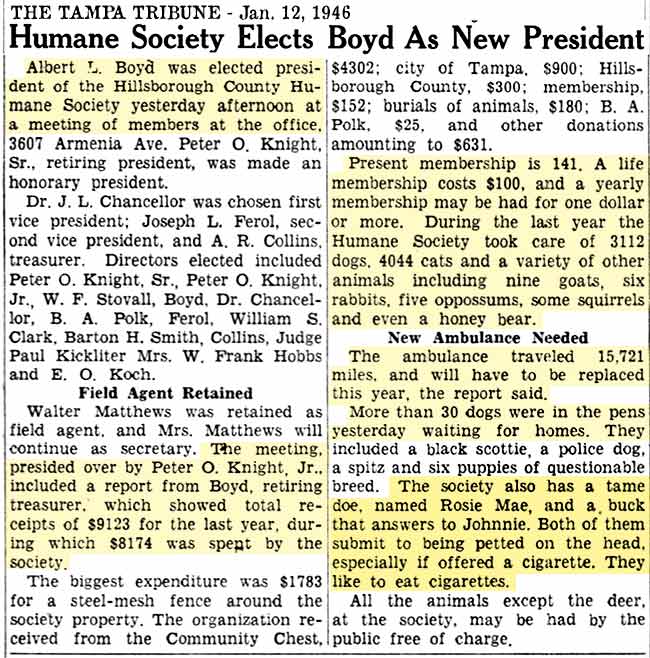 |
The
society acquired a new ambulance on Dec. 2, 1946.
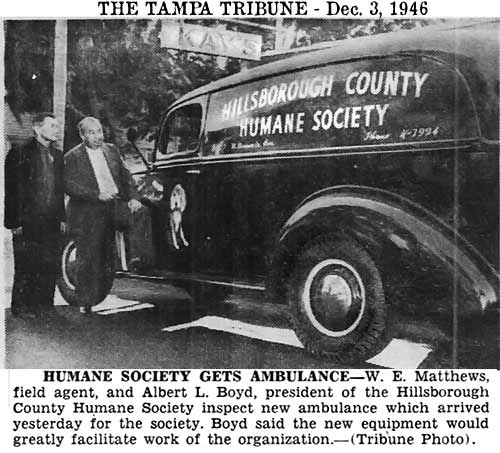 |
|
In
1947, Boyd was reelected a president of the
Humane Society. Peter O. Knight is
referred to as "Col." Colonel was used in
the South a title of social status, it was not a
military rank. It was a title usually
afforded to older, affluent, successful and
well-respected white men. Among the new
members of the board was Peter O. Knight, Jr.
The Society took in almost $1,000 more than the
previous year, but spent nearly all of it.
Boyd was also a member of the board of the
county Juveniles Home.
|
|
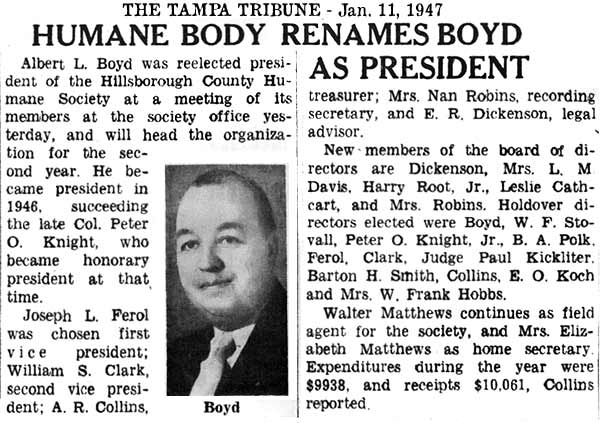 |
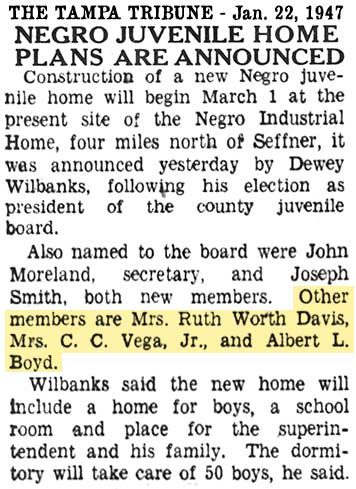 |
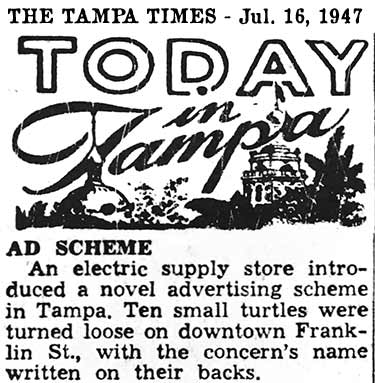 CRUELTY
TO ANIMALS QUESTIONED CONCERNING TURTLE ADVERTISING CRUELTY
TO ANIMALS QUESTIONED CONCERNING TURTLE ADVERTISING
In mid-July, 1947, ten small
turtles were painted with advertising for an electric supply
store and turned loose on Franklin St. The Times
thought it was a novel scheme.
The Humane
Society received two complaints concerning the turtles
roaming Franklin St. with advertising painted on their
shells. Albert Boyd, although a former zookeeper and
now president of the Humane Society, was indecisive as to
whether or not a turtle was even an animal, stating, "I
have not determined the status of a turtle in the animal
world." Whether or not this was factual
reporting remains to be seen. Hopefully, it wasn't.
Boyd issued a "stern statement of disfavor on the
use of turtles as advertising media."
It's not clear
if the next quote of Boyd is Boyd quoting the complaint he
received, or the reporter's quote of Boyd's own statement:
"As
pointed out by the complaints," Mr. Boyd declared,
"The creatures--whatever they are--could cause plenty
of trouble, aside from the humane
aspects of the situation. Not only could they crawl
into the path of cars and get smashed, but
their shells could puncture tires and cause accidents.
Besides, some driver might become startled, swerve, and
cause an accident." So was it the
complainer who brought up the subject of the danger to
humans, or was it Boyd?
Boyd claimed
if it had a gizzard (stomach), it's an animal. The
Times reporter then proceeded to make fun of the situation
and go into various classifications of animals.
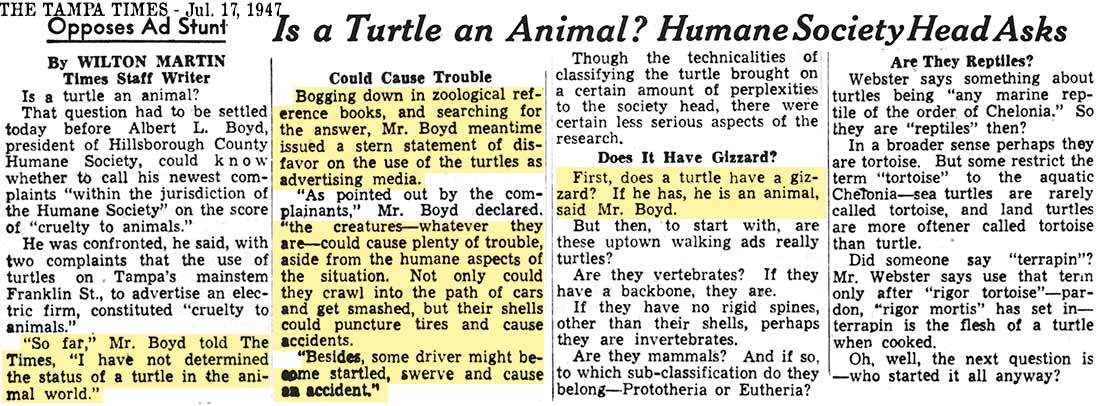
.
|
Boyd
was chairman of the Safety Patrol sticker sales
and each year raised
funds for the school boys and girls patrols trip to Silver Springs. |
|
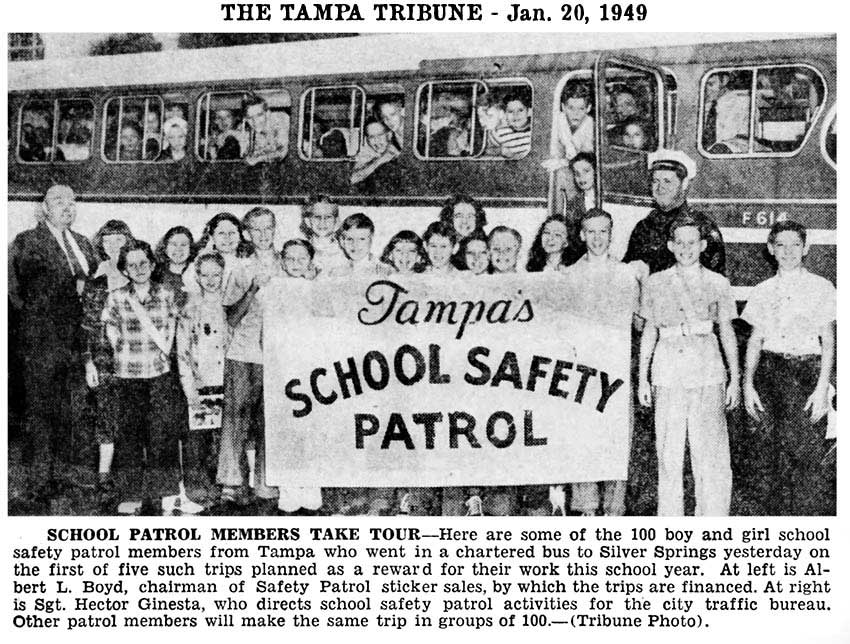
In April 1951,
only the boys went. Maybe the girls were
going on a separate trip, or they were naughty
that year. Notice all of the club's
officers were women.
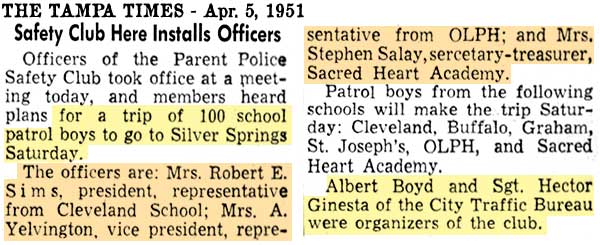 |
DEATH OF ALBERT LEO BOYD
Albert Boyd died at his home on Aug. 32,
1952; he was 54 years old. His brief
obituaries do not mention the cause of his
death.
The Tampa Tribune carried the same obituary,
almost verbatim, but added "...civic leader for
the last 30 years. Both made the same
error in saying he was president of the Humane
Society for the last 10 years. He may have
been a member for 10 years, but he was president
for just over 6 ½
years. Also, the Tribune used an older
photo, the one which was used in the Jan. 11,
1947 article when he was elected president of
the H.S.
Boyd was
survived by his widow, Mary Boyd, son Albert L.
Boyd Jr. and two sisters in Washington D.C. |
|
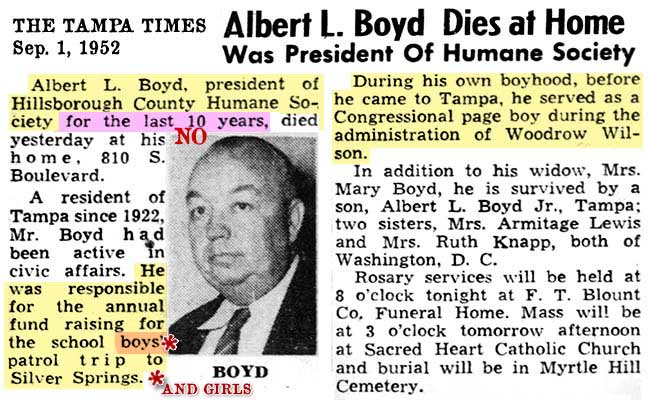
|
Lowry Park Beginnings
The
Courthouse Fountain & Sulphur Springs zoos
Plant Park Zoo
Boyd's Sunoco Zoo
Fairyland
Sheena the Baby Elephant & Jim Godfrey
Herman - King of the Zoo
Safety Village / Children's Museum /
Kids City
Dr. Bragg's Fantasia Golf
Saving Fairyland!
Zoo
1
2 3
4
5
|
|


 Albert Leo Boyd was born in Washington D.C. to local physician
George Washington Francis Boyd and his wife Clara R. Esch Boyd on Aug.
20, 1898. Albert was the
youngest
of seven children according to their 1900 Census in DC.
The record showed every member of the Boyd family was born in the Dist.
of Columbia. George's father was born in Ireland and his mother in
Maryland. Clara's parents were born in Germany. (These
columns have been omitted.) George and Clara had been married for
16 years and all seven of their children were living in the home. The Boyds were well off, they had a live-in nurse as well as a cook (from
Ireland.)
Albert Leo Boyd was born in Washington D.C. to local physician
George Washington Francis Boyd and his wife Clara R. Esch Boyd on Aug.
20, 1898. Albert was the
youngest
of seven children according to their 1900 Census in DC.
The record showed every member of the Boyd family was born in the Dist.
of Columbia. George's father was born in Ireland and his mother in
Maryland. Clara's parents were born in Germany. (These
columns have been omitted.) George and Clara had been married for
16 years and all seven of their children were living in the home. The Boyds were well off, they had a live-in nurse as well as a cook (from
Ireland.)







 In late 1928 Albert became
the manager of the "Teapot Dome" Texaco service station at the corner of
Ashley and Madison Streets. Advertising on Jan. 1, 1929 "Under its
new management, this service station will strive to make 1929 the
biggest year..." by rendering a "high type of service." He offered
"cordial, personal contact--with skilled men giving the closest
attention to carrying out your wishes."
In late 1928 Albert became
the manager of the "Teapot Dome" Texaco service station at the corner of
Ashley and Madison Streets. Advertising on Jan. 1, 1929 "Under its
new management, this service station will strive to make 1929 the
biggest year..." by rendering a "high type of service." He offered
"cordial, personal contact--with skilled men giving the closest
attention to carrying out your wishes." It also appears that in the
late 1920s, Albert Boyd was in the bail bonds business. He was in
the papers for various cases, some very high profile capital crimes
cases, with at least one other bondsman listed-- Armando Dominguez.
In May 1929, an article appeared in the Tribune "Government Begins
Action To Collect $27,650 in Bonds." Among the dozens of bondsmen
listed were Armando Dominguez of 2575 Union St. and A. L. Boyd of 1417
E. Frierson Ave., bondsmen for Jack Wallace, for $2,000, and A. L. Boyd
& Armando Dominguez of Ross and Nebraska Avenues, bondsmen for Raymond
Rodriguez, for $5,000.
It also appears that in the
late 1920s, Albert Boyd was in the bail bonds business. He was in
the papers for various cases, some very high profile capital crimes
cases, with at least one other bondsman listed-- Armando Dominguez.
In May 1929, an article appeared in the Tribune "Government Begins
Action To Collect $27,650 in Bonds." Among the dozens of bondsmen
listed were Armando Dominguez of 2575 Union St. and A. L. Boyd of 1417
E. Frierson Ave., bondsmen for Jack Wallace, for $2,000, and A. L. Boyd
& Armando Dominguez of Ross and Nebraska Avenues, bondsmen for Raymond
Rodriguez, for $5,000.
 KNIGHTS
OF PYTHIAS FRATERNAL ORDER
KNIGHTS
OF PYTHIAS FRATERNAL ORDER  By 1930 Albert was a member of the Knights of Pythias and D.O.K.K --
Dramatic Order, Knights of Khorassan lodges.** Boyd was on the
entertainment committee. It is this activity that seems to have
inspired Boyd to be a "showman," albeit of strange and wild
animals, but still, this was entertainment.
By 1930 Albert was a member of the Knights of Pythias and D.O.K.K --
Dramatic Order, Knights of Khorassan lodges.** Boyd was on the
entertainment committee. It is this activity that seems to have
inspired Boyd to be a "showman," albeit of strange and wild
animals, but still, this was entertainment.





 On Feb.
6, 1932, Albert Boyd
also felt the impact of a truck. He was painfully injured when he was hit by a truck while walking along the
side of State Road No.17 several miles east of Tampa. Boyd had
pulled off the road and was trying to find his way through the dense
morning fog and smoke when he was struck by a Furtel Farms Company truck
On Feb.
6, 1932, Albert Boyd
also felt the impact of a truck. He was painfully injured when he was hit by a truck while walking along the
side of State Road No.17 several miles east of Tampa. Boyd had
pulled off the road and was trying to find his way through the dense
morning fog and smoke when he was struck by a Furtel Farms Company truck
 driven by a Seffner man. Boyd suffered a broken leg and in mid-May, 1932, he filed suit against the Furtel Farms company for
damages of $25,000.* The article stated that a similar case such
as this one had been brought to court recently and was dismissed.
driven by a Seffner man. Boyd suffered a broken leg and in mid-May, 1932, he filed suit against the Furtel Farms company for
damages of $25,000.* The article stated that a similar case such
as this one had been brought to court recently and was dismissed.






























 No,
that's not her name and age.
No,
that's not her name and age.






























 Just
three months after Boyd's big 3-year celebration,
in mid-Dec. 1936, Beauty was euthanized using ether and chloroform
because she had been seriously ill for several days. The illness
was thought to be the long-term effects of an intentional poisoning from
a year earlier. At that time, it was thought that she had fully
recovered. But a month ago, she began showing signs of illness
again which worsened.
Just
three months after Boyd's big 3-year celebration,
in mid-Dec. 1936, Beauty was euthanized using ether and chloroform
because she had been seriously ill for several days. The illness
was thought to be the long-term effects of an intentional poisoning from
a year earlier. At that time, it was thought that she had fully
recovered. But a month ago, she began showing signs of illness
again which worsened.































 BOYD
WITHDRAWS AS CANDIDATE FOR MAYOR
BOYD
WITHDRAWS AS CANDIDATE FOR MAYOR






 CRUELTY
TO ANIMALS QUESTIONED CONCERNING TURTLE ADVERTISING
CRUELTY
TO ANIMALS QUESTIONED CONCERNING TURTLE ADVERTISING


